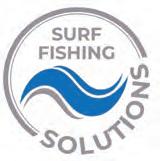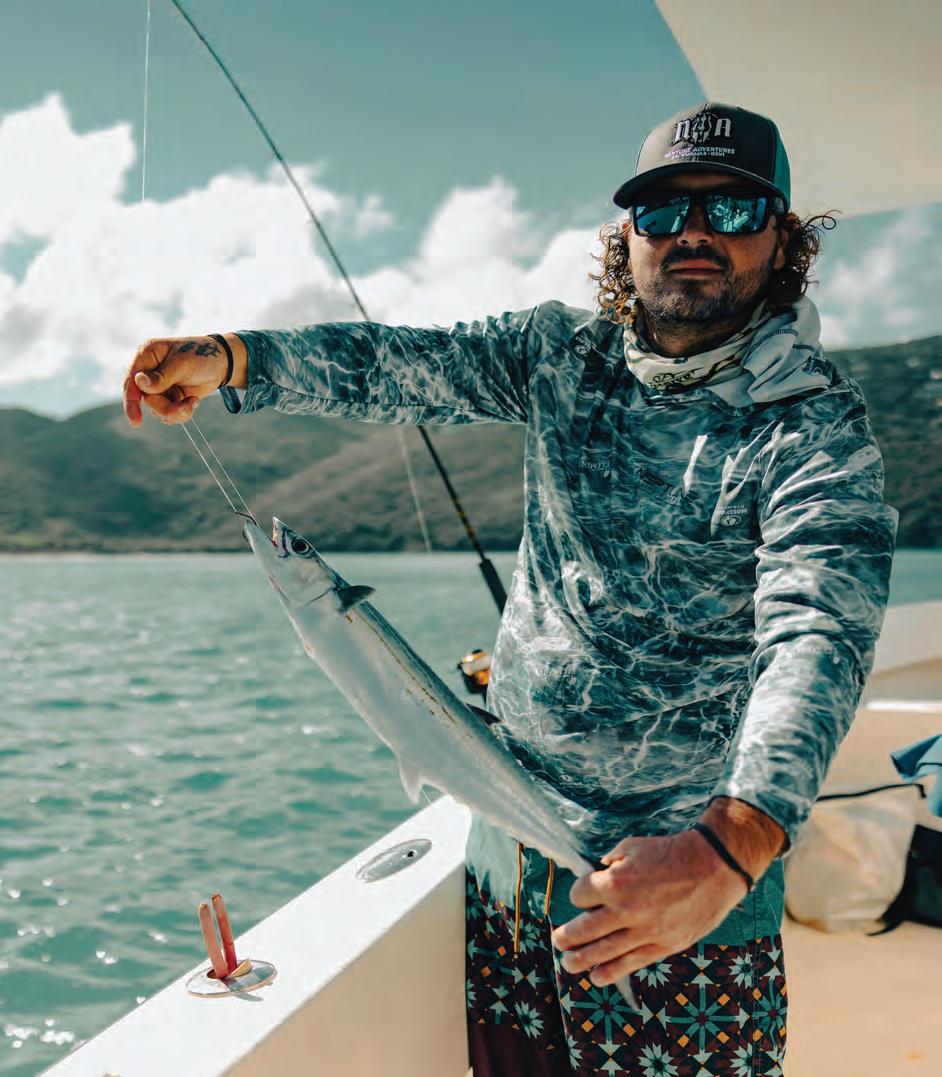






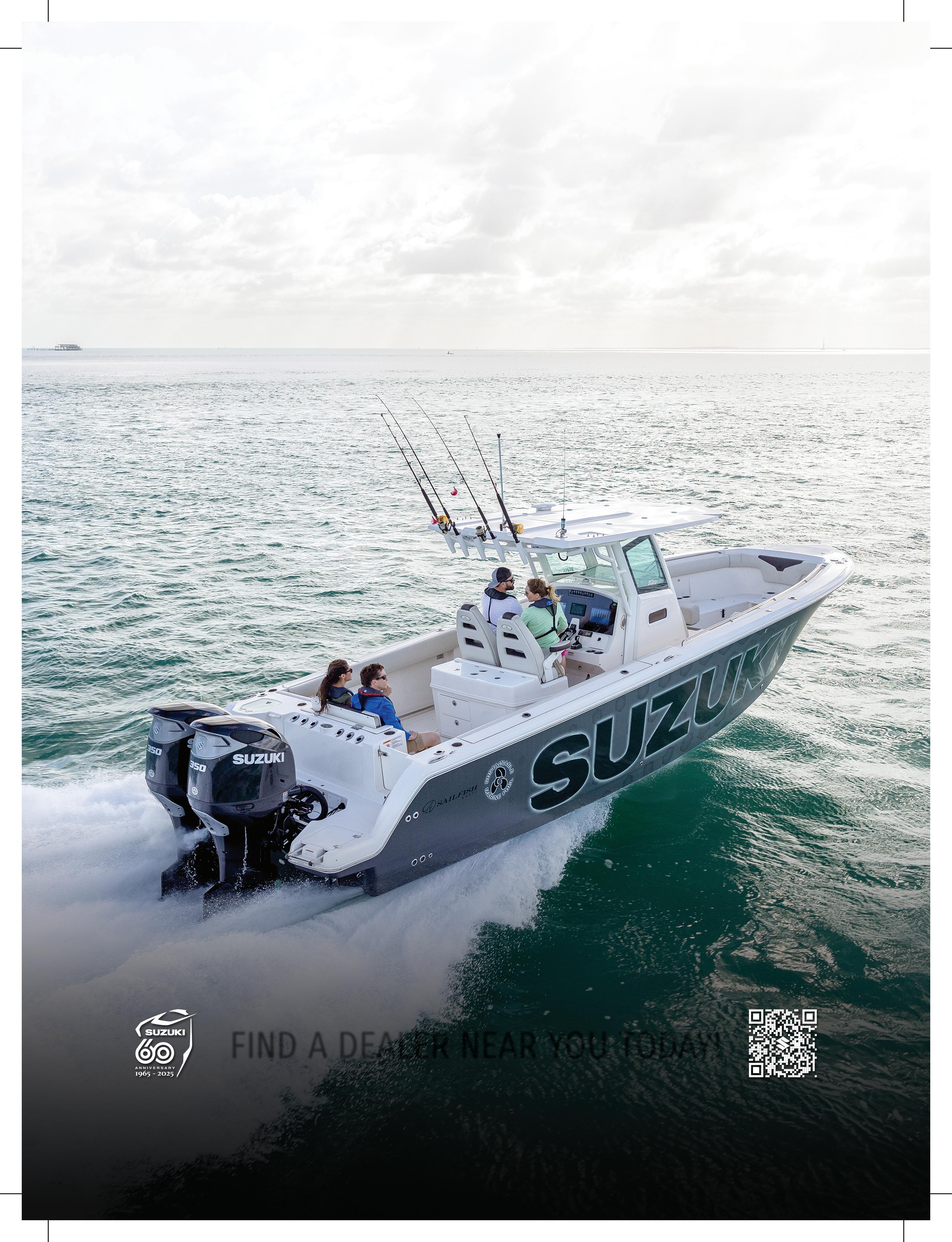

















Ever see a commercial harbor full of Furuno Marine Electronics and wonder why the pros rely on us?


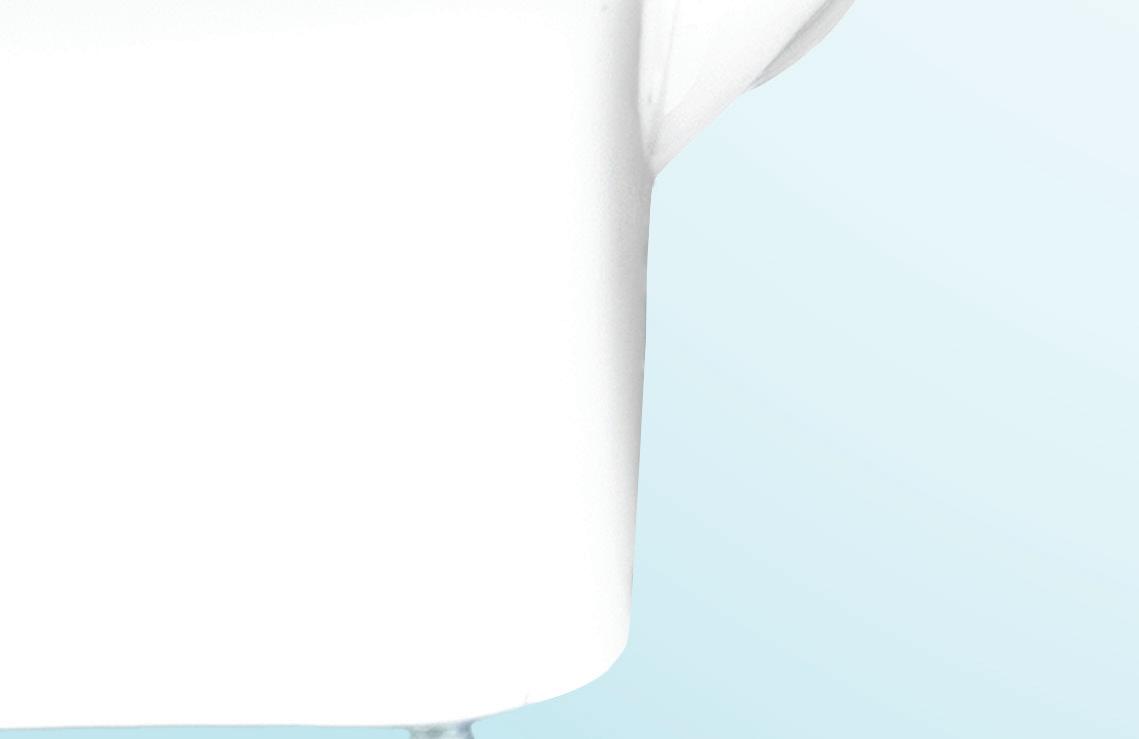


See why here









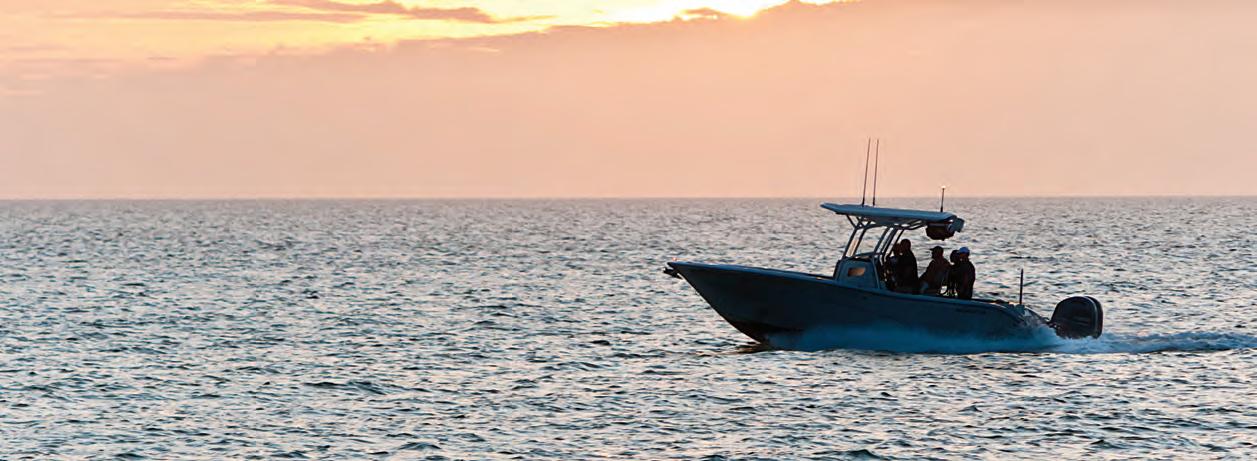
Are you ready to embark on your next on-water adventure? Before you set sail, here are fve things to know about boat insurance.
1. Boat insurance isn’t just for accidents
With comprehensive coverage, you’ll also be protected fnancially for theft, vandalism, and unexpected events like storms if you need repairs or replacements due to damage.
2. Accidents can happen to anyone
When accidents happen, boat insurance offers liability coverage for damages or injuries you cause while boating, up to specifed limits. It can also cover lawsuit costs if you’re sued.
3. Boat insurance can cover medical payments
Boat insurance offers a range of optional medical payments coverage limits, helping to cover medical expenses if you’re in an accident or someone is hurt on your boat, regardless of fault.
4. Most lenders require boat insurance
If you fnanced your boat, you’ll likely need boat insurance since most lenders require boat insurance to protect their investment. Additionally, some marinas or municipalities require proof of insurance for docking.
5. Progressive offers specialized boat coverages
Ever worry about getting stuck on the water?
Progressive’s Sign & Glide® On-Water Towing coverage** can help. It’s an additional coverage that steps in if your boat is disabled or breaks down on the water, paying for on-water towing, jump starts, soft ungroundings, and fuel delivery. Fuel cost isn’t included.
Don’t let unforeseen circumstances disrupt your voyage. Cruise with confdence thanks to Progressive Boat insurance. Because when it comes to your boat, peace of mind is the ultimate luxury.
Scan to get a quote in as little as 4 minutes.
to learn more.



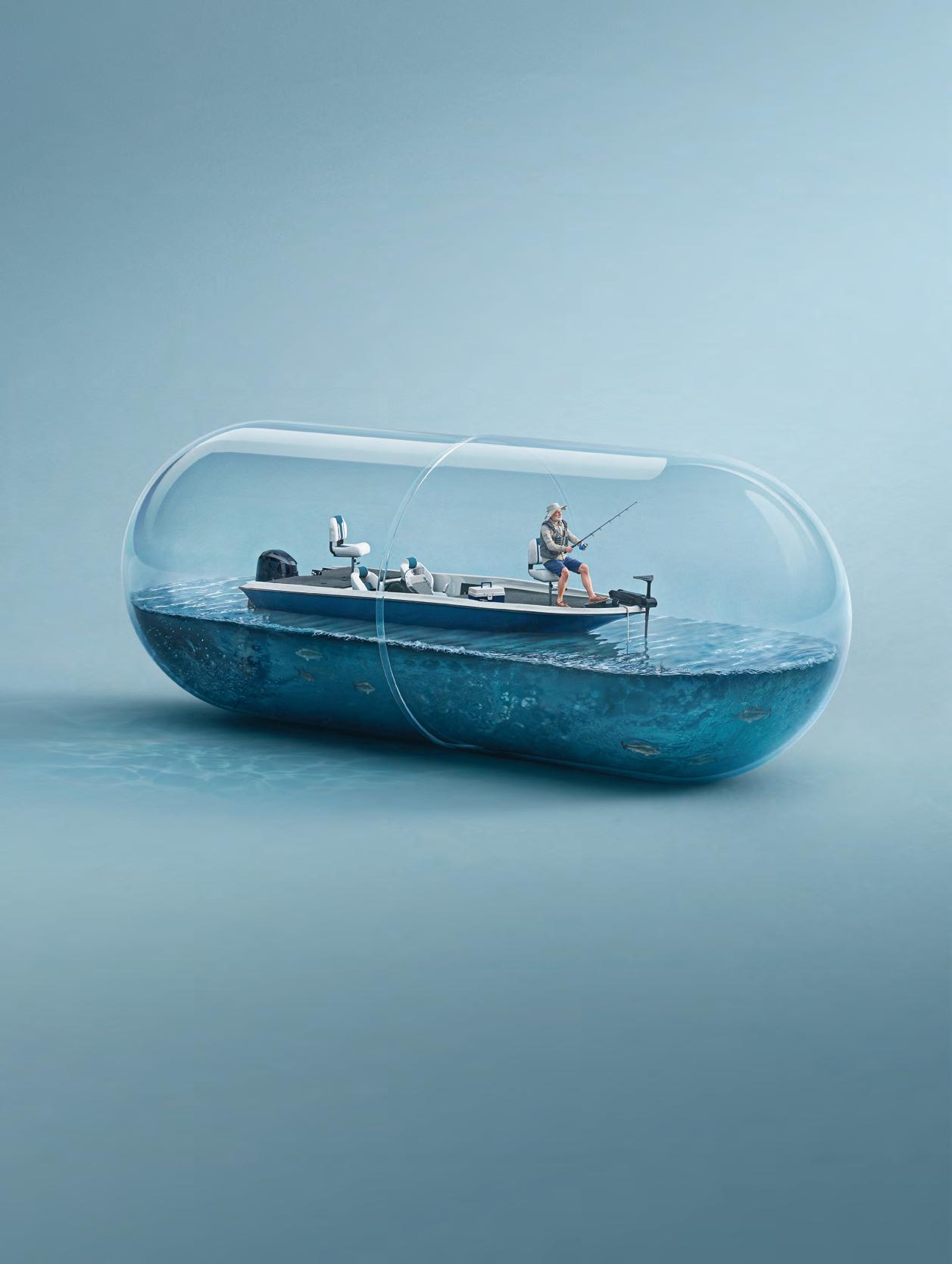
















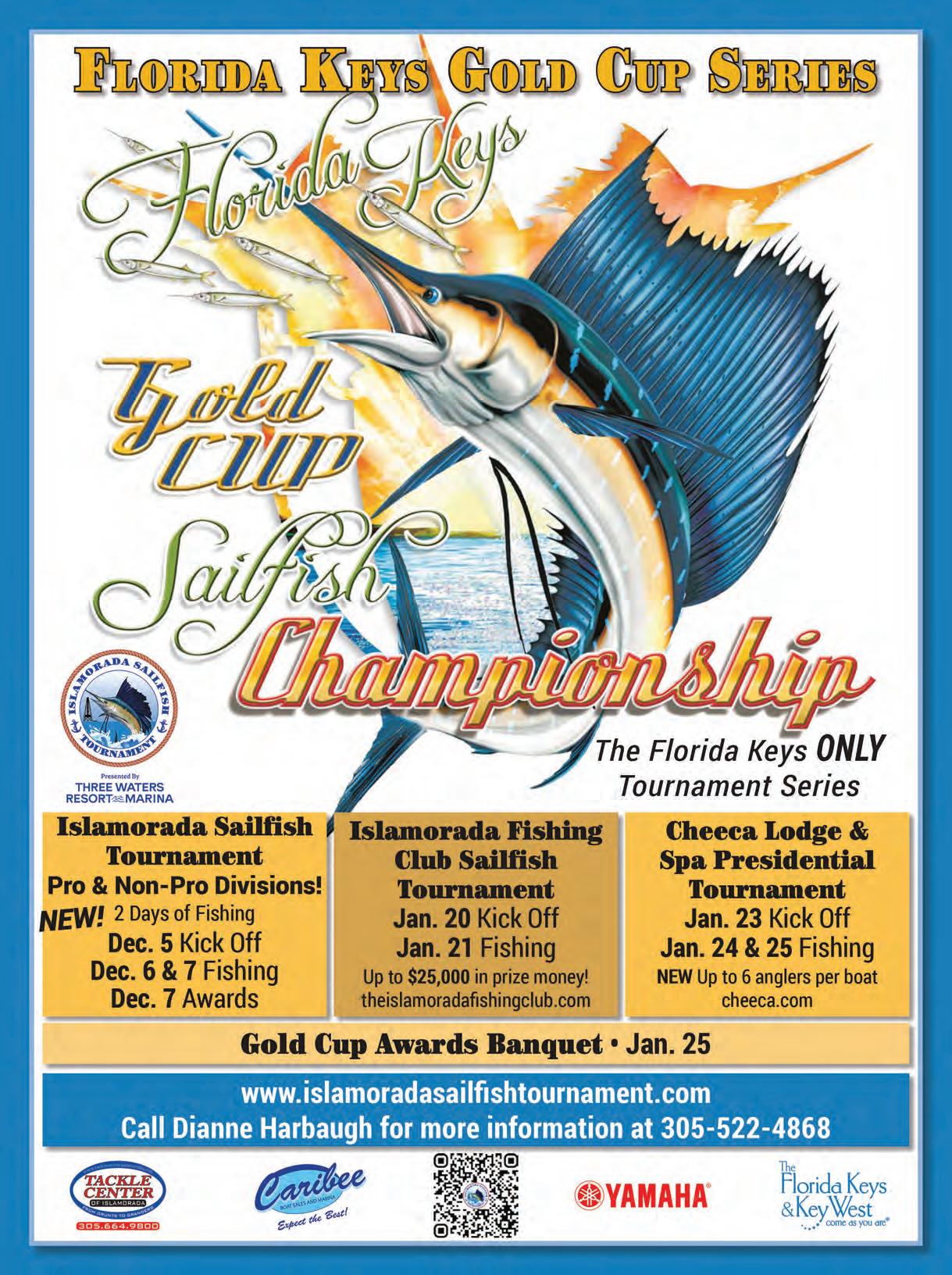


There’s remote, and then there’s Pulley Ridge. Sitting over 100 miles o! the coast of Florida, this underwater plateau is where the Gulf of Mexico drops into the deep blue, and it’s earned a legendary reputation as one of the most productive, and challenging, shing destinations in the U.S.


By Astrid deGruchy
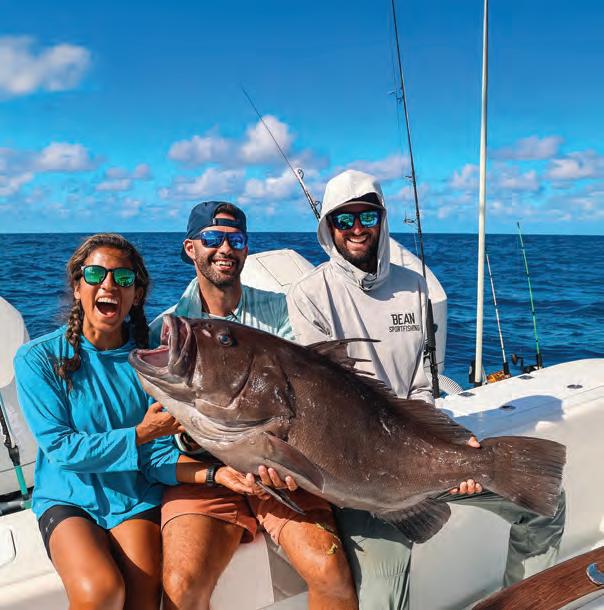

If you’re heading out there, you’ll need a serious o!shore machine. ink a 47’ Freeman or a Viking, something that can handle the long run and unpredictable Gulf conditions. is isn’t a trip for small center consoles or light tackle. Last time we were out there, we loaded up with PENN Fathom electrics paired with PENN Ally Electric rods & PENN International 50 VISX ready to drop into depths that test both your gear and your patience.
Using chicken rigs, we hauled in vermillion and yellow snappers in over 500 . of water that lled the box, but Pulley Ridge has a wild side where giant groupers and the occasional “what-the-heck-is-that” monsters lurk in the dark.

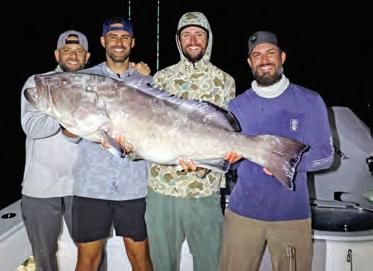
Pulley Ridge isn’t just another shing trip, it’s a rite of passage. e distance, the depth, the unknown, it all adds up to one of those bucket-list adventures every angler should do once in their life, especially with a crew of buddies who live for the chase. While you’re out there, you can even make a stop at the Dry Tortugas, another incredible o!shore destination rich in history and beauty.
Check out the full Pulley Ridge expedition on YouTube, only on Bean Sport shing TV.




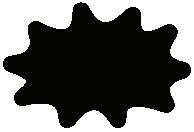


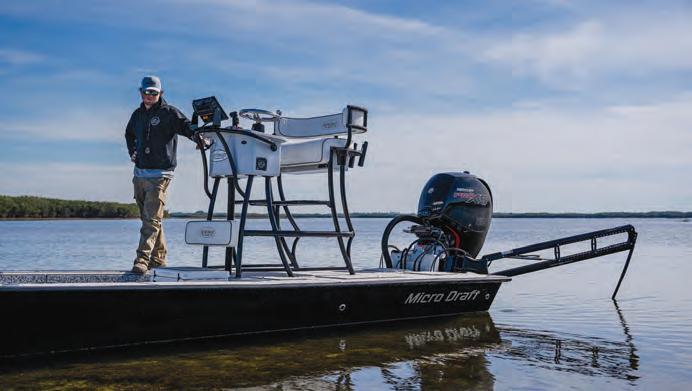



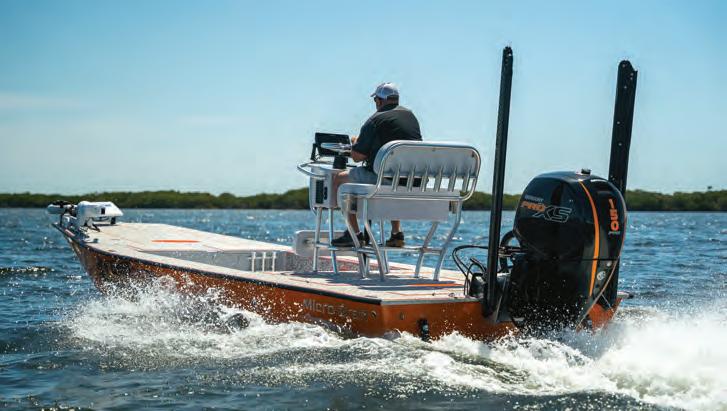
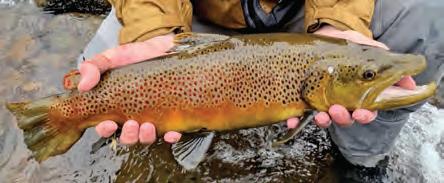
By Julie Graham

The Cherokee National Forest o!ers some of the best freestone trout shing in the Southeast. Spanning 650,000 acres across the Southern Appalachians, it’s the largest block of public land in Tennessee and it’s divided neatly in two by the Great Smoky Mountains National Park.
On the north side, mountain streams tumble through hemlock hollows toward Cosby. To the south, the waters of Citico Creek cut deep through wilderness ridges near the Unicoi Mountains. Together, they showcase the Cherokee’s range. From roadside creeks to backcountry runs, the forest o!ers anglers a taste of freestone Tennessee trout water.
Below the Great Smoky Mountains National Park boundary, Cosby Creek winds through the community of Cosby, Tennessee, o!ering accessible trout
water without the added park permit. ese lower stretches are regularly stocked by the Tennessee Wildlife Resources Agency (TWRA) and can provide productive shing throughout spring and fall. While access is somewhat limited, anglers will nd several bridges and pull-o!s along Highway 32 where they can wade in. e streambed is rocky and slick, with plenty of boulder pockets and undercut banks—good traction and careful footing are essential. Expect stocked rainbows with the occasional brown trout.
Inside the Park, the Cosby Campground section is ideal for bank shing and light wading, especially for those who prefer easy access close to trails and picnic areas. Brook trout dominate the upper reaches, while rainbows hold in the deeper pools below.
To the south, Citico Creek drains more than 20,000 acres of rugged country on the western edge of the Cherokee. Fed by the north and south forks rising in the Unicoi Mountains, Citico o!ers a blend of stocked and wild trout water—ideal for anglers who like a mix of easy access and adventure.
e TWRA regularly stocks Citico from Little Citico Creek to the Citico Creek Wilderness boundary, while the upper forks hold self-sustaining populations of wild rainbows and browns.
e Cherohala Skyway marks the southern edge of the Citico Creek watershed, and just driving it is worth the trip—sweeping vistas, ery fall colors, and the sound of water around every bend.
Autumn is prime time on both sides of the Cherokee National Forest. Water temperatures drop, trout feed hard before winter, and the hardwood ridges turn to ame.
• Match the Hatch: Early fall favors terrestrials; in November, go small with blue-winged olives, midges, and caddis emergers.
• Go Light: Clear, low ows call for 6X or 7X tippet and longer casts.
• Mind the Leaves: Dri leaves can snag a line—look for deeper pools below ri&es where trout hold under cover.
• Start Late: Cooler nights mean shing o en improves mid-morning as the water warms slightly.
For more information, including licensing regulations, visit the Tennessee Wildlife Resources Agency at https://www.tn.gov/twra.html.


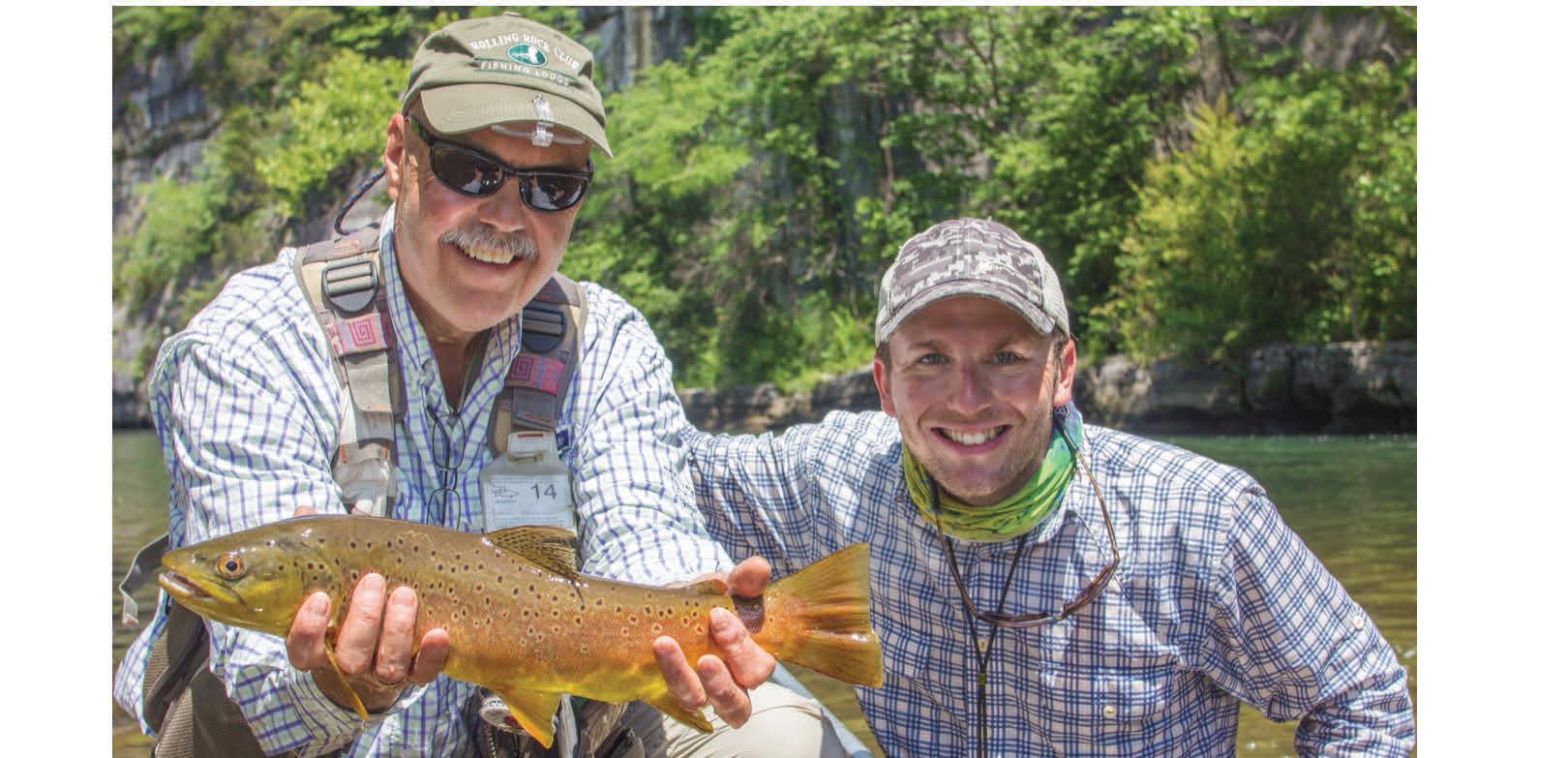











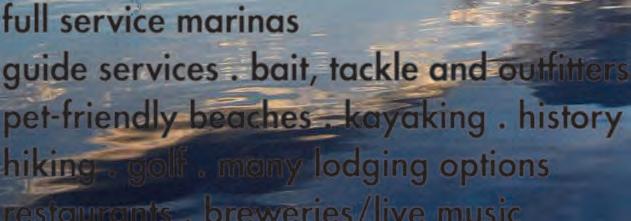




























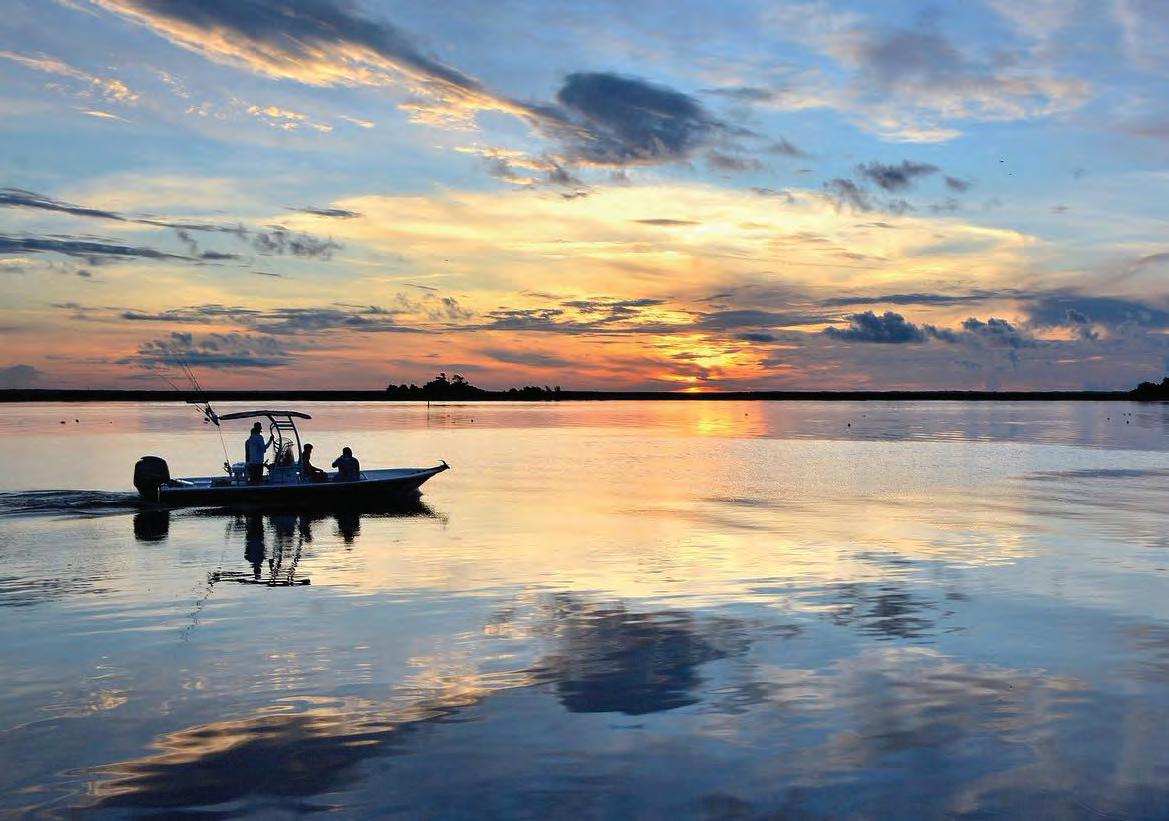


















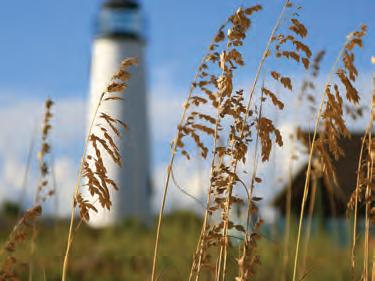







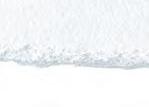
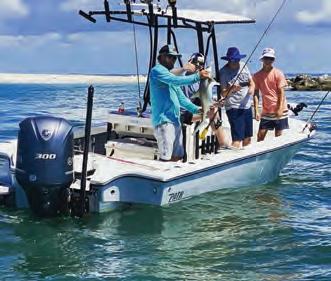
















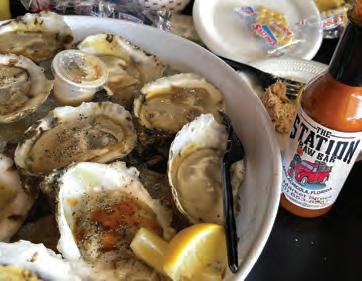
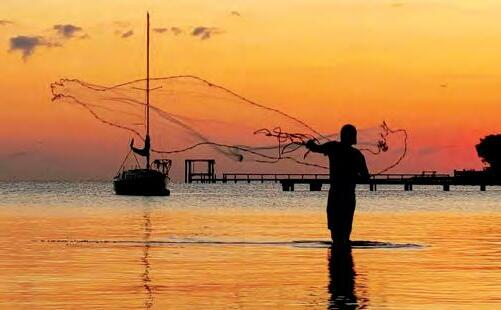
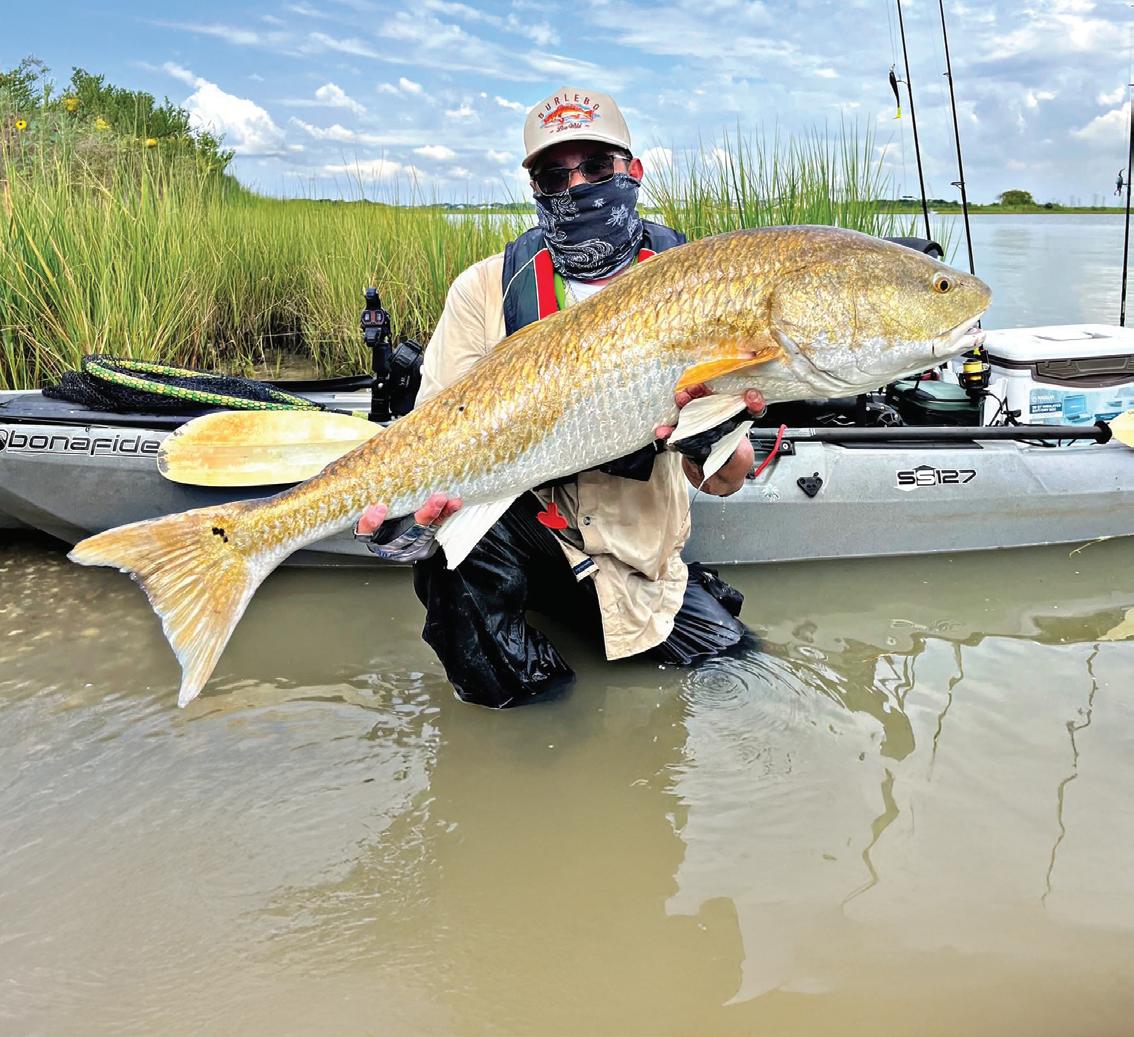
By Capt. Michael Okruhlik
There’s just something magical about fall shing. e air cools, the bait thins out, and everything that swims gets a little hungrier. For me, it’s the holy trinity of the season— ounder migrations, trout and reds chasing shrimp under screaming gulls, and the early whispers of trophy trout time.
The Fall Flounder Run
Ah, yes, the famous fall ounder migration. is is more prevalent in some areas, but they can be caught all along the Gulf Coast. ese at ambushers stack up near the passes as they make their way to spawn in the
Gulf, gorging on bait along the way. When I’m targeting ounder, I switch things up. My go-to is a scented so plastic, preferably the Titan Series from Knockin Tail Lures. Not only are they scented, but they also have a rattling tail. Working this along the bottom will entice violent strikes. Since ounder love to bury themselves and wait in ambush, I keep that lure tapping bottom, twitching my rod sideways, whether I’m wading or boating. It’s a nesse game—part patience, part persistence—and when that telltale “thump” hits, it’s pure satisfaction.
Birds, Bait, and Mayhem
en there’s the chaos of gulls dive-bombing over shrimp and schooling sh—a sight that’ll make any angler’s pulse jump. Fall o en brings bigger trout into the mix, turning every cast into a thrill. I prefer to use a heavier jighead (1/4 to 3/8 ounce) to achieve the desired action without spooking the birds or the sh. Durable so plastics help keep me in the ght longer, and I mash the barbs down for quick releases and faster re-casts. When the schools settle and the birds thin out, a topwater lure can coax the bruisers to rise— and few things beat watching a big trout explode on the surface.
As fall rolls on, my focus shi s toward trophy trout—and timing becomes everything. I’ve followed solunar shing tables since childhood, back when my grandparents’ calendars marked “good” and “poor” shing days with little sh icons. Over the years, I’ve been both a believer and a skeptic, but I’ve noticed a pattern: my best bites o en align with solunar peaks. Now, I plan my day around them. Instead of running and gunning, I’ll anchor in a promising area during a predicted feeding window and wait it out.
On a recent trip with my boys, we missed the morning bite but stuck it out for the next solunar cycle. We anchored near a grass edge meeting a sandy at and, right on cue, rods bent. For seventy glorious minutes red sh hit every few casts, and sometimes we doubled up. My sons were smiling, the drag was screaming, and the solunar chart earned another believer that day.
So as the air cools and the sh feed up, grab a rod, bring a kid, and let the tides—and maybe the moon—guide your next adventure.
Capt. Michael Okruhlik is the inventor of Knockin Tail Lures,® and the owner of www.MyCoastOutdoors.com.




Mastry Engine Center has received the Suzuki Marine Super Service Award and has been ranked #1 in Suzuki Marine US Sales! 60 YEARS OF REPOWER EXPERIENCE!

RePower Packages designed to best ft your needs and not stretch your budget.
Financing available.

Rest assured, all Mastry Suzuki RePowers are backed by Suzuki’s industry leading 5-year factory warranty.

Stationed strategically around the East Coast, all Suzuki RePower Centers have achieved the highest level of Suzuki certifcations to meet and exceed your repower needs.
When Considering A Repower, Consider These Factors:
•Every Authorized Mastry Suzuki RePower Center has decades of repower experience providing proper rigging, controls, propeller matching and in water testing
•With a Mastry Suzuki RePower, owners gain improved performance, less noise and greater reliability
•Mastry Suzuki RePower’s exclusive Owner’s Edge Program*
•Mastry Suzuki RePower Centers use authentic Suzuki OEM parts and have factory certifed technicians

Since 2014, Mastry Engine Center, has been building the premiere Suzuki Outboard repower network in Florida. Today, Authorized Mastry Suzuki Outboard Centers have been exceeding expectaions in the Southeast for over two decades. Recently Suzuki Marine requested Mastry Engine Center to expand the network throughout the Northeast. Now boat owners from Maine to Florida can be assured of the best support for their Suzuki outboard repower project. All Authorized Mastry Suzuki RePower Centers provide the best options, information and package pricing for excellent performance in repower.
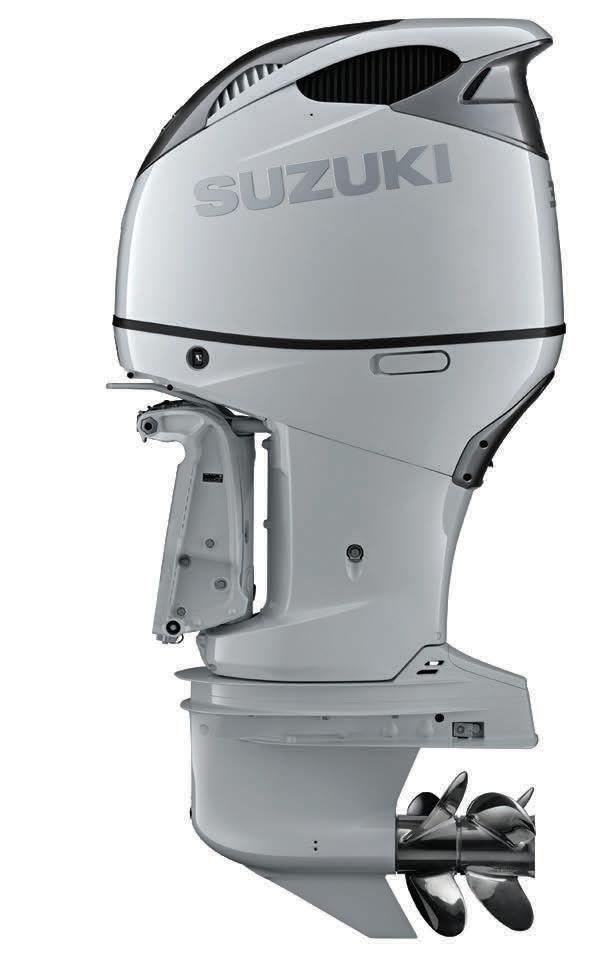



When you purchase a new Suzuki outboard from an authorized Mastry RePower Center you qualify to become a member of the Mastry Suzuki Owner’s Edge. Owners receive an identifcation card that provides them with important information about their Suzuki outboard motor as well as a passport to additional benefts during ownership. Members enjoy a detailed engine maintenance schedule, Mastry Suzuki RePower Trade Program and special pricing from Mastry Suzuki Partners *Get with the Program!
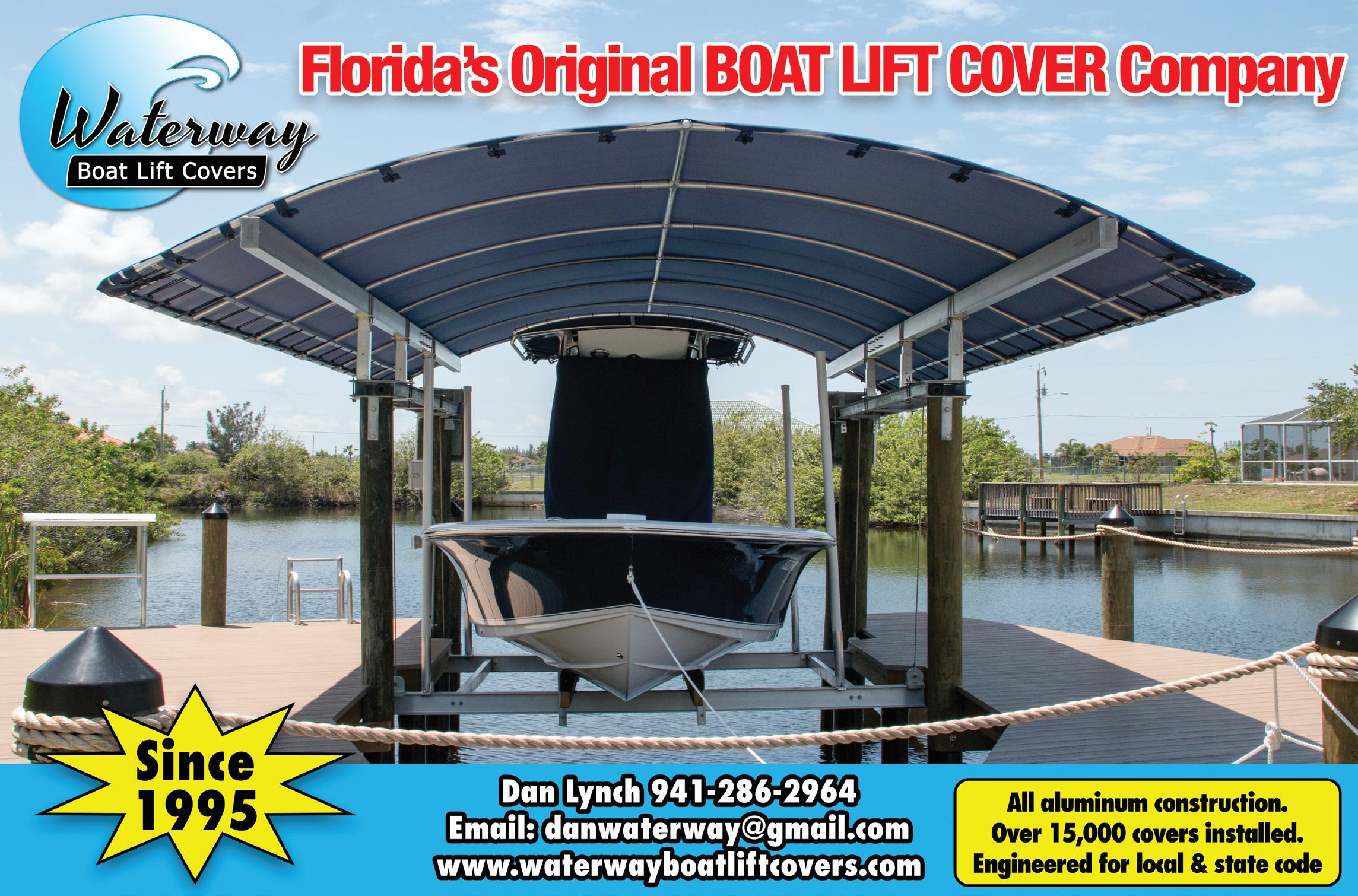
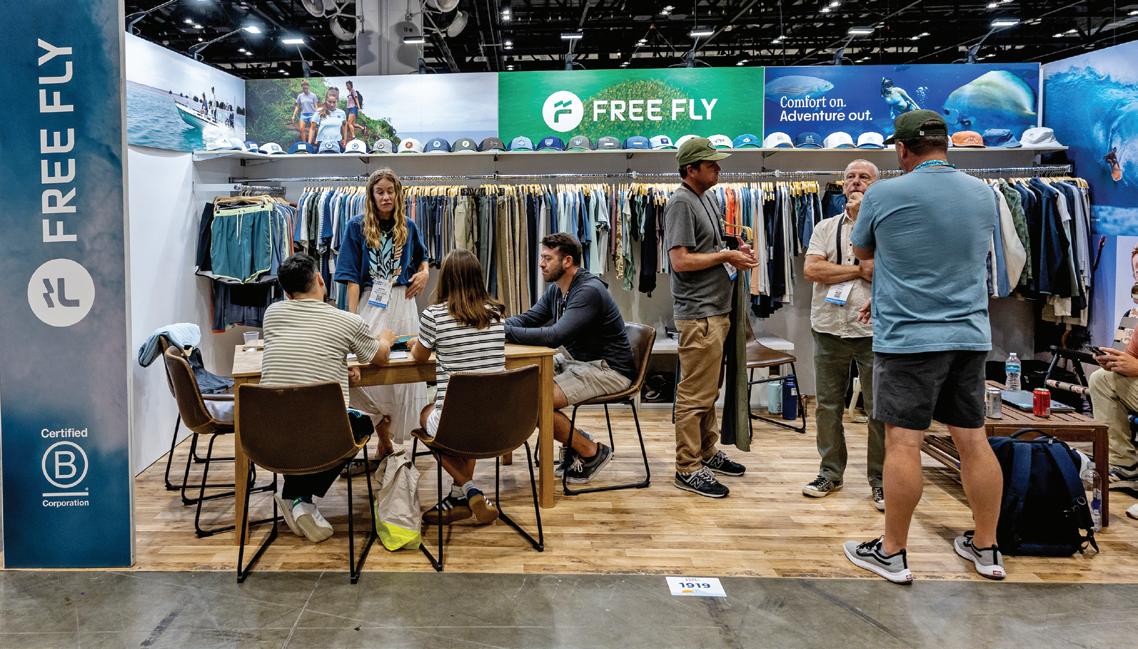
In the world of watersports and outdoor lifestyle, staying connected to what’s next isn’t optional—it’s essential. For 50 years, Surf Expo has been where the industry comes together to discover new products, make connections, and set the tone for the season ahead.
Returning to the Orange County Convention Center in Orlando, January 7–9, 2026, Surf Expo celebrates its 50th anniversary with an event that honors ve decades of driving the business of the waterman lifestyle forward. e show draws thousands of quali ed retail buyers, brands, and industry professionals from across the U.S. and around the world.
Surf Expo has long been the industry’s launchpad for what’s next. It’s where new brands make their debut and where trusted names unveil their latest collections. On the show oor, sustainability, functionality, and style continue to drive the next wave of coastal and outdoor retail—trends that shape what ends up in your store and, ultimately, in the hands of your customers.
Re ecting the growing connection between coastal and outdoor lifestyles, Surf Expo’s Shoreline Outdoor area continues to expand— bringing together products designed for life on the water and adventures on land. is growing segment highlights essentials for outdoor adventure, from versatile apparel and gear to innovative accessories that move seamlessly from coast to camp.
Shoreline Outdoor features brands and products that bridge categories—boating, shing, paddling, hiking, and camping—meeting consumer demand for versatility and performance. Retailers will nd quality, functional, and sustainable products built for modern outdoor enthusiasts. ink waterproof bags, insulated coolers, portable re pits, backpacks, multifunctional jackets, and drinkware designed for any setting. is lifestyle focused area captures the spirit of adventure—friends gathered by a re pit a er a day on the water, paddleboards pulled up on the sand, or cozy campsites under starlit skies. It’s all about embracing the outdoors in every way.
What makes Surf Expo such an essential stop on the retail calendar? It’s the unmatched variety. Hardgoods, apparel and accessories that bridge the gap between beachwear and everyday wear, Surf Expo delivers products that de ne coastal and outdoor living. Whether your customers are anglers, surfers, paddleboarders, kayakers or simply love the water or the outdoors, you’ll nd fresh lines and innovations that resonate.
Surf Expo remains much more than aisles of product—it’s a place to learn, connect and recharge your business strategy. Educational sessions, in-booth demos and networking events o er valuable insights into consumer behavior, merchandising and market trends.
Join them January 7–9, 2026 as they celebrate 50 years of Surf Expo— and experience rsthand why this show continues to be the heartbeat of the coastal and outdoor lifestyle industry.
Quali ed retail buyers register for free before 12/24 at surfexpo.com

Welcome to a new era for Coastal Angler Magazine! We are thrilled to introduce ourselves, Henry and Dominic, two native Floridians and accomplished captains, as the proud new owners of the Greater Jacksonville edition. Our vision is clear: to elevate Coastal Angler Magazine to its fullest potential and provide the best outdoor and angling magazine possible. This exciting takeover will be complemented by a dynamic and interactive social media campaign, designed not only to be engaging and fun but also to drive significant business growth for our partners. Get ready for a fresh perspective and a renewed commitment to celebrating the best of the Greater Jacksonville Coastal Angler community! Our extensive professional experience as fishermen, coupled with our deep local knowledge from countless days on the water, ranges from stalking redfish in the backcountry to trolling for trophy catches. We are both connected to the University of North Florida—Dom is a recent business graduate, and Henry is currently enrolled. We have a way with contacts and connections and probably know your friend and your
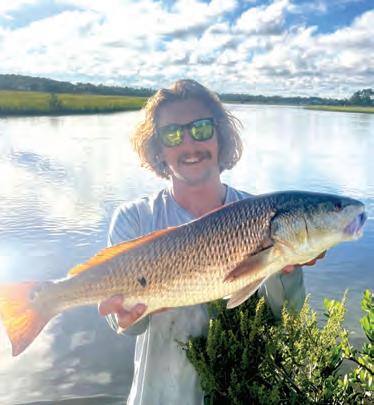
friend’s friend. We are deeply passionate about this magazine and its future and are committed to providing readers with unparalleled local sportsman knowledge, highlighting businesses we genuinely trust and depend on, and passionately protecting, promoting, and supporting the entire Coastal Angler marine and outdoors family! Welcome to the family, and feel free to reach out to us about anything from fishing to business, as they’re two of the things we stand on.

Capt. Henry Benoit – (904-347-6997) Capt. Dominic Anderson - (904-962-6184) jaxcoastalangler@gmail.com
The Jacksonville Offshore Sport Fishing Club (JOSFC) has several events coming up this November. Come help us celebrate the achievements of our Junior Anglers at the Junior Angler Awards Night, November 6th, 7:00 PM, at the William “Bill” Gulliford, Jr. (Mayport Community Center).
70.03-pound WAHOOOOOOO. Come join us for hamburgers, hot dogs, and great desserts.
We will be serving FREE sausage & cheese biscuits and coffee at the Hagan Ace Hardware/ Hagan Coastal Outfitters up in Callahan, FL on November 15th from 7:00 AM to 10:00 AM as they host the “Outdoors Show” radio broadcast LIVE. Come find us at the JOSFC bright blue tent and say hello (don’t forget to grab a biscuit).
Our Annual JOSFC Thanksgiving Feast with turkey, ham, “fixin’s” and desserts will happen on Thursday, November 20th, 7:00 PM. This time of year, is always a great time to reflect upon all the blessings that we are grateful for, on and off the water. Please come join us for fellowship, friendship, great food and a fish story or two. We meet the first and third Thursday of each month, doors open at 6:00 PM, Dinner at 7:00 PM, Educational/Guest Speakers at approximately 7:30, a little Club business and then we close each meeting with a great Raffle. Guests are always welcome. Come check out our fishing club. We would love to meet you. We would love for you to become a member.
Keep making memories out on the water.
Our Junior Anglers have been fishing diligently throughout the last year both Inshore and Offshore, as well as, setting new JOSFC Junior Angler Club Records. Our First Place Inshore Junior Angler is Atley Tavares, and our First place Offshore Junior Anglers are Eloise Sands and Noah Baker. And how about Teagan Malone’s Junior Angler All Time Club Record
Darrin “Doc” Willingham JOSFC President “Living the Dream”

By Capt. Tommy Derringer
Does it get any better than the fall fishing in Northeast Florida? I don’t think so! After what seemed like the hottest summer ever it will be a nice change to have some Air temps that are nice and cool. The fishing will stay hot though, as the fish start to fatten up for the winter. Flounder will be on everyone’s mind, and not just regular old flounder, but huge doormats that show up here as the water cools down. Redfish and trout will be up on the flats just begging for you to toss your favorite top-water plug their way. Christmas comes early for Northeast Florida fisherman.

not losing at least a few rigs every time you fish the inlets for flounder, you’re probably not fishing close enough to the rocks.

Our flounder run got off to a great start in October and should continue to be good through November. Yes, I know they are closed to harvest, but they are still fun to catch. Every year from October through November, anglers seem to catch some of the biggest flounder of the year. The go-to rig for most is going to be a finger mullet pinned to a fishfinder rig. I like to use about 12-18” of leader attached to a swivel with enough weight above the swivel to get to the bottom. Another great rig is simply a jighead paired with either a mullet or mud minnow. Both St. Augustine and Mantanzas inlets will be great spots to catch some big flatties this time of year. Fish close to the structure (rocks) and don’t be afraid to lose some rigs. I tell people all the time, if you’re


As the water cools down, the redfish and trout will start to group up on the flats and in the creeks. We’ve had a ton of wet weather over the last couple months, making for murky water conditions but cooler water temps can mean better water clarity, which in turn means it’s almost time for sight-fishing in our area…. The past couple of years November has been epic as far as a redfish bite goes. My absolute favorite way to fish for redfish is to sight-fish them! Let’s just hope for a dry end to the Fall season. Schooling reds and trout will tend to hang in warmer areas this time of year. Dark oyster-laden and darker mud bottom will warm up on sunny days and hold redfish and trout, as well as other inshore species. You will also find reds and trout schooled up in creek holes on the low tide stages. We get some good negative low tides this time of year, and when that happens you can bet the fish will be hunkered down in those holes. On the lowest tides focus on the little runouts right along the ICW that come off some of the bigger flats. Those areas will hold the bait and in turn, the redfish.
Sheepshead will be turning on over the next couple of months. You can find them just about anywhere this time of year, but the hardcore “sheep herders” will be fishing along bridge pilings, inlet rocks and just about any kind of riprap around. The baits of choice will be shrimp, clams, and just about any type of crab, with fiddlers topping the list for the sheepshead. Just remember, with sheepshead you’ll need to use your cat-like reflexes with you set the hook.
Capt. Tommy Derringer 904-377-3734 • www.InshoreAdventures.net

by Samuel Vigneaul
Are coastal development projects a threat or a benefit to our world-class fisheries in Northeast Florida? A deeper look into this issue reveals the answer is not as obvious as one might think. In recent years, the state of Florida has continued to grow in population. Families are relocating from other states while the tourism industry continues to boom. This means more home construction, more hotels, and as a result, more roads and bridges to accommodate more people.

Initially, the thought of increased development in the Sunshine State concerned me. Woodlands being leveled to make room for neighborhoods, and new infrastructure impacting the natural habitat of our native wildlife.
At the rate of our expansion, words like “overdevelopment” and “habitat destruction” are common topics among outdoorsmen whose passions are put at risk.
With all this urban sprawl, is there any hope for the wildlife that makes this state so special? In regard to fish specifically, I believe the solution is to find a balance between the excessive growth and the creation of new habitat for our cherished species.
It often seems that nobody talks about the ways in which man-made infrastructure might actually improve fishing. I have been guiding fishing charters in Saint Augustine for over 6 years. One thing I’ve noticed is that big fish love structure. While a fallen tree could shelter a few big fish, the bridges we build can harbor hundreds. I find it interesting that today some of the best places to catch big fish are around bridges, jetties, docks, seawalls, and shipwrecks, none of which existed before human intervention.
This proves that fish are adaptable, resilient, and opportunistic. While environmentalists are often at odds with new building projects and their effects on local wildlife, this is something to consider.
Going forward, the ideal solution is to establish a synchrony between coastal development and habitat improvement. We should study the ways in which human development could benefit the species it displaces. Humans will continue to reshape their surroundings to accommodate their needs. In doing so, it is crucial that we provide the same consideration to our native wildlife.
Capt. Samuel Vigneault Nexgen Fishing Adventures 772-321-6657

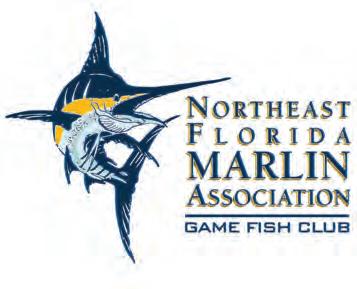


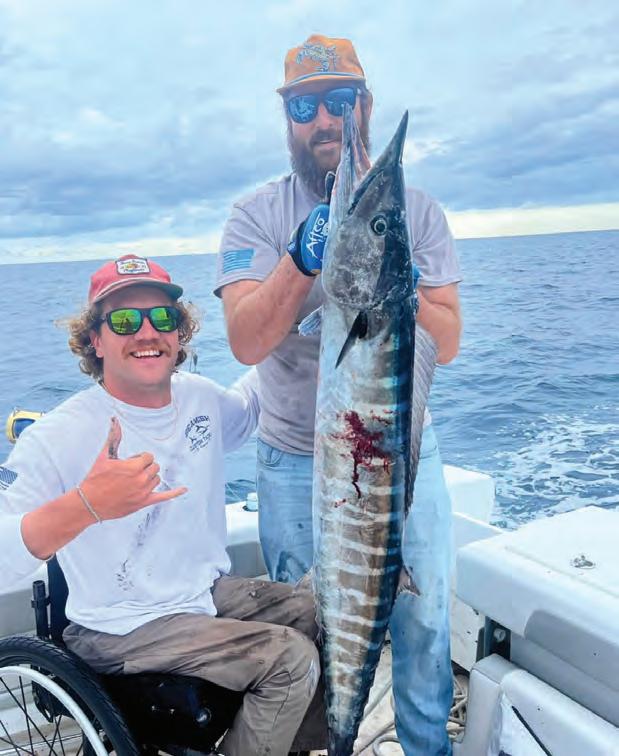
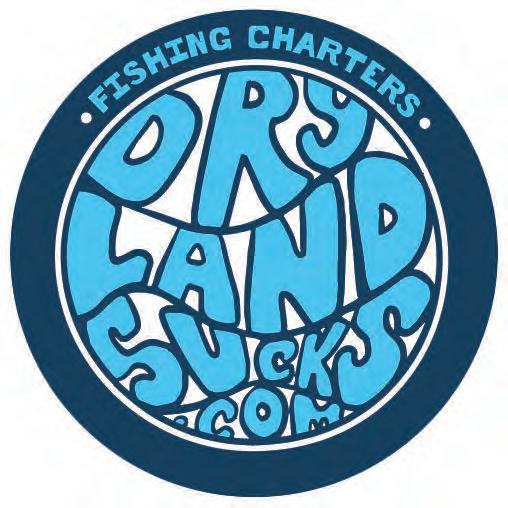

By: Noel Kuhn
Finally November! Cold fronts moving in from the Northwest brings us cooler temps that drops our water temps. That means the fish will really turn on which include Pompano returning from North Carolina where they spent the Summer. Also the big Redfish will be filtering back out to the surf once they have finished spawning in our inlets. This is welcome relief from all the Nor’easters that just about ruined the Mullet Run in late September and the first half of October.
My favorite way to target these big Redfish is to use a fish finder rig tied out of 50 pound monofilament. Enough lead to keep in the deepest trough on the beach. Hook size will vary depending on your bait size. I like a 7/0 circle hook when using a lady fish head, Whiting head or one half of a Blue Crab. If using a small cut bait or a big shrimp I drop down to a 5/0 circle
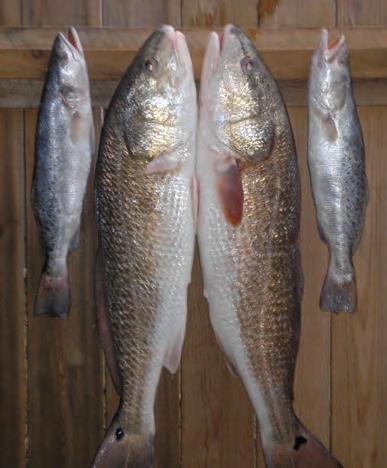

hook.
The biggest Pompano of the year come late when the water temp drops below 70 degrees. 64 to 66 degrees is where I have caught all of my six pound plus silver nuggets. Since the Sand Fleas have gone deep to hibernate, my go to baits are Blue Crab knuckles and live clams. If you have never used live crabs just google “Blue Crab knuckles”.
If you can still cast net some finger mullet, sometimes till mid December, try dragging them in the first trough on a fish finder rig. I tie mine out of 30 pound mono with a 3/0 circle hook. Big Seatrout, Flounder, Redfish and Bluefish will gobble them up. If you strike out with the cast net, a jig head with a paddle tail fished slowly usually gets it done. My favorite is the tried and true red jig head and white paddle tail. Keep in mind with cooler water temps the fish do not hesitate to feed in shallow water. My first six pound Pomp was in November on St Augustine beach. I had two rods banging with Pomps as I was casting my third one. I quickly did a half hearted cast. It maybe went ten yards into just three feet of water. When I finished reeling in the first two Pompano I looked at rod number three and it was doubled over with the drag screaming. Fish short and shallow and set your drag light!



by Alex Womack
Whenthe moon is full and the king tides of the fall run high, the spartina grass will flood on Florida’s First Coast. The high water in the marsh allows redfish to access flats that are rarely under water. This phenomenon has a positive effect, providing the reds new real estate to hunt in and added items to their menu. This same flood tide that covers our tall grass and mangrove trees has a directly inverse effect on birds of the marsh such as the Clapper Rail, better known as the Marsh Hen. The high tide reduces most of their cover that they use to hide in when it floods. The result is a concentration of the birds that makes them possible to hunt effectively and kicks off a seasonal southern tradition as well.
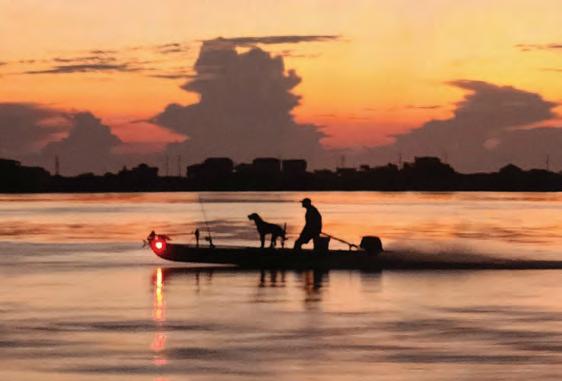
Here in Northeast Florida, we enjoy a substantial tidal swing that averages a healthy 4-6 feet each switch four times a day, every day. Additionally, in the late summer and fall we have what are known as King Tides or flood tides. These periodical swings fluctuate depending on a combination of critical conditions and create these abnormally high tides. This large differential can be a blessing, a curse, and an inevitable learning curve for anyone navigating our NE Florida coastal waters.
Marsh Hen season begins on the first day of September and ends on the ninth of November. It all starts with reading the tide chart. These tides are an abnormal phenomenon but seasonally they are extremely predictable-if that makes sense. These are the highest tides we see all year and can vary but they come around this same time of year annually. In addition, a full or new moon will push the tide anywhere from 1-3 extra feet above our normal levels. Ideally you will want your tide prediction to read well over 5 and a half feet (5.5) as on good days it will call for over 6 feet of high water, creating a truly proper fishing or hunting flood tide.
Pay attention to the wind as well. Here in our area, moderate to strong NE winds are common, especially in this season and are partially responsible for adding to the higher water levels. Educate yourself on the charts and numbers you find on most marine forecast sites or tide and weather apps. Knowing these numbers will save you time, headaches from wasted days, and keep you safe.
Bring a gun that doesn’t mean the world to you because it will get wet, saltwater wet. I use a 20 GA Stoeger M3020 coated with camouflage cerakote. It is lightweight to carry on the bow all day and the smaller gauge helps to not ruin the meat that we are after on these smaller birds. It has been a great gun, and it’s not pricey nor is it sentimental which is perfect for the tough conditions we put it through hunting in the salt marsh.
Be sure not to forget at least one rod equipped with a light top water, plastic, or fly for when you see one of those tails for the first time that day. One local secret and long-time favorite bait is a weedless top water bass frog. Talk about a fun bite. The visual nature of flood tide sight fishing makes it more like hunting. When the tide floods, anything can happen. Persistence pays off and if you are out there long enough, it will happen. You will want an old pair of tennis shoes, boots, or anything you can tie on tight and keep on. You do not want to get in the waters of the salt marsh with out a good pair of tied up tight tennis shoes or durable bottom wading shoes that won’t come off to avoid life changing shellfish lacerations that are undoubtedly lurking in the murk below.
It is best to get where you want to start hunting by riding the last hour or so of the incoming high tide on your way back into the creek. This way allows the boat to be easily poled with the tide back into the flooded grass, hunting and looking for redfish tails on your way in. You will find that this technique works both ways. You can pole the slack-highest peak of the tide as far back into the flooded stuff as you can get and lastly ride the outgoing tide while easily poling yourself out for the day. Hunting waterfowl while under power (motor & trolling motor included) is illegal. For this reason, one will want to use the “with the tide” technique for more efficient area coverage. Smarter not harder, you know the saying. If you are not seeing the birds move as much as expected, the mystery of their whereabouts will be solved every time they cackle and crack in the creeks when they’re responding to each other. It is a beautiful sound. A sound that can spread for miles across the marsh as they sound off together. Slow down and listen. Hear the clapping—find the rails. They will file out of the taller grass, running across floating grass mats and swimming across small creeks between high points of the flat looking for cover. They jump and flush at the sound of a hull approaching their dead grass island or mangrove home as the boat is poled over the snail lined spartina grass. When you do eventually begin shooting at these flighty targets, pay attention for follow up shots on other birds spooked from the same area you just shot in. Also, the birds will disclose themselves and provide your direction for your next approach when they begin sounding off again after you shoot.
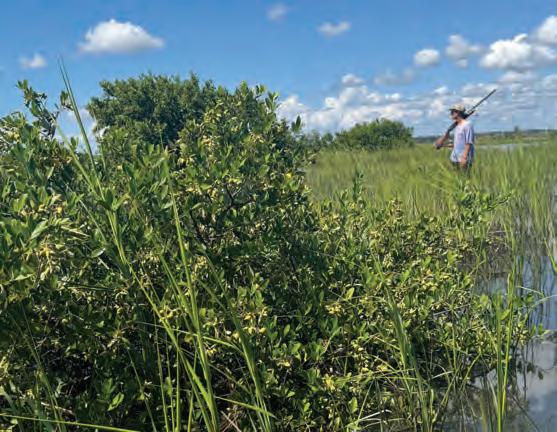
Safety First
Don’t be afraid to get up close and personal. The most fun and often most effective way you will find them will be jump shooting them as you
pole along, so be ready. Be careful when you swing while aiming for the flighty targets, especially if you are in a 16 foot Gheenoe like us. A little communication will go a long way in keeping things safe.
The shooting is quick, close, and can be surprisingly humbling. After a few misses an even half decent shot can usually figure it out and dial them in. When the birds start flying, things happen fast. A hen flushes left— a quick swing of the shotgun—a burst of brown feathers. Keep an eye on your bird as it hits the water. It can be easy to lose and hard to find these illusive birds, even if you think you smoked one—it is best to act fast and get em’ in the boat. Unless of course you are lucky to have a four-legged friend to help you find them.
I love to bring Cash (my German short haired pointer) and after much hard-earned retrieve training, he has been great for a couple of years for hens and one duck season. By no means do you need a dog for this style of hunting, and I would venture to say that a good gun dog is unnecessary for most waterfowl hunting in Florida. Even with Cash boy on board for most of our hen hunts, he will only be sent on half of the birds on a “busy” day. Scooping them up with landing net as you pole by or hopping in yourself and being the worlds biggest bird dog are popular secondary options. Just remember, wear some form of a solidly strapped on full coverage shoe before getting in. Trust me.
The marsh bottom that is not covered in oysters is soft and can be unforgiving. If you step in the wrong spot while wading around out there you can sink knee deep or worse into the “puff mud.” This nightmarishly soft sediment that we are plagued with here in our neck of the woods can prove to be a feat of physical strength if one wades into one of these unfortunate spots. So be mindful of your distance from the boat if you decide to wade and do not wade alone. This will not only make things safer but easier as well. I am a fan of both.
After the Hunt
As the tide turns and the water begins to fall, the birds melt back into
the grass. On your way out of the creek, always keep your eyes peeled looking for a shot at a last-minute buzzer beater tailing redfish. It is time to head to the hill. I have never seen a boat dirtier than after a long hard marsh hen hunt. Time to clean the boat, the guns, the dog, and start dressing our birds.
Hunters can keep no more than 15 birds per person and up to 45 birds as the total possession limit for the boat. When cleaning your marsh harvest, don’t just go for the breasts and forget the legs! If you are not keeping them whole, like a miniature Cornish game hen, for just a few extra seconds you can get them breasted out and have the legs and thighs broken down as well. This way we also use every part of these birds while respecting every aspect of the animal.
If you really want to go full circle back to nature, our Florida stone crab season begins on October 15th, and the scraps left over after dressing the birds can make for a half decent crab bait. Marsh hens make for more than fine table fare. Simply marinate your dressed birds in your favorite stuff and grill them up, you can’t go wrong.
I wrote this to be semi educational, mostly inspirational, and ultimately invitational. An open invite to get outside with friends or family and get on the water with one another. An invite to learn something new, do something you miss doing from your past, or a chance to teach a kid something they may fall in love with forever. Just like my family and I have.
From the tidal creeks of Mayport, down through Palm Valley, and south past Matanzas —the beautiful expanses of our tidal salt marsh are waiting to be explored by you and yours. There are more and more of us hunting and fishing out there these days so please respect each other’s space, respect the marsh, and always practice safety when hunting on the water. Have fun, be safe, catch em up, and good hunting everyone.
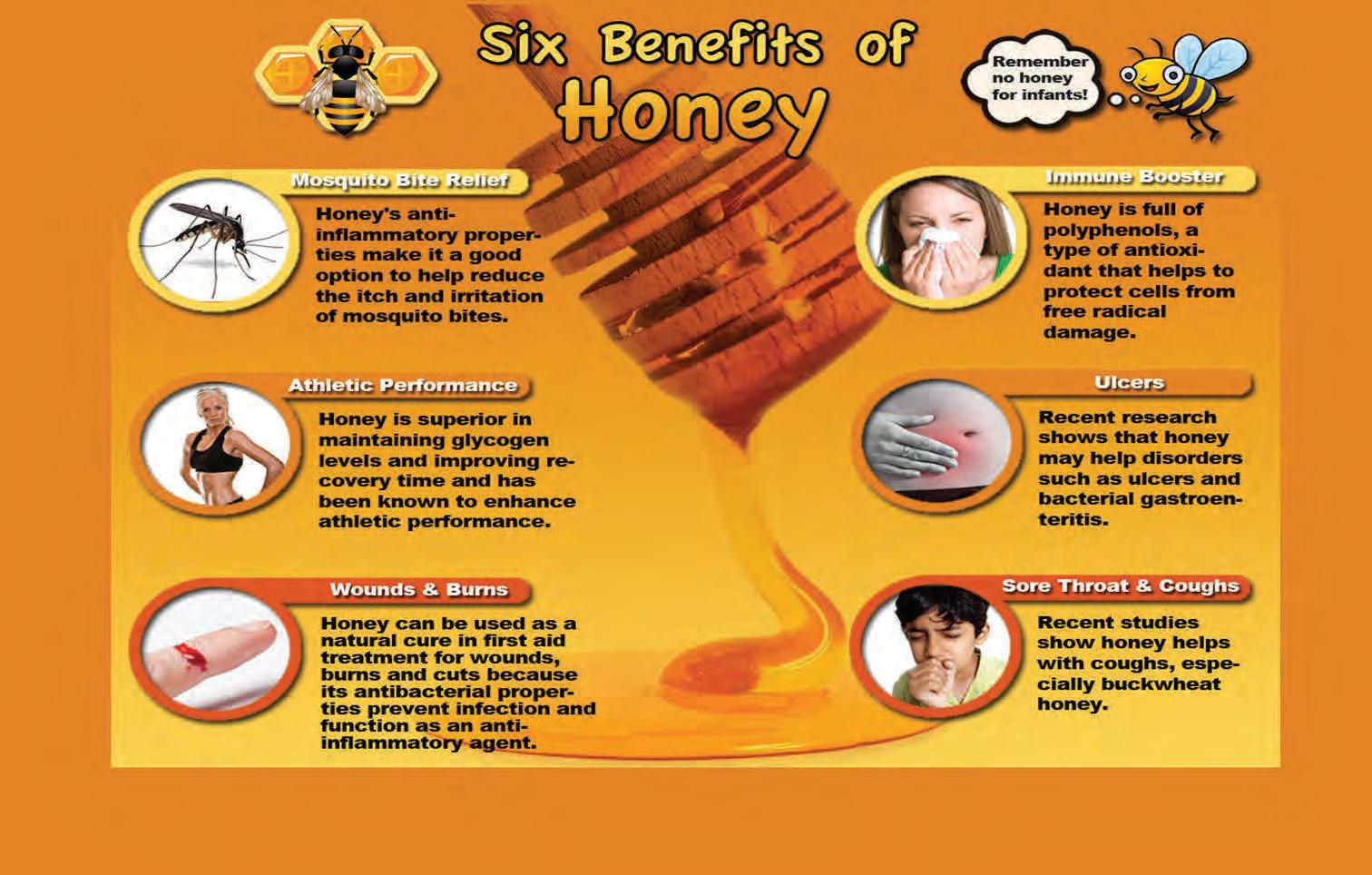
By Terry D. Lacoss
One of my very best backwater fishing trips took place during the month of November, and several fishing seasons passed. I was fishing with TV personality and famed bass angler Roland Martin and his wife, Judy Martin. We had timed the tides perfectly, which after launching Martin’s bass boat, the tide was two hours away from flooding.
Casting cigar shaped surface plugs over flooding oyster mounds produced awesome redfish action, that at times would literally blow our plugs a foot or so out of the water! Redfish strikes were so exciting that one over the slot limit redfish that blew up on Judy’s “Zara Spook”, blew it right back into our boat!


Other species of backwater saltwater game fish that will be taking surface plugs during the month of November include seatrout, bluefish and jack crevalle. The best action will come during the last few hours of the flooding tide and the first hour of the falling tide. Areas that offer the best topwater fishing action include tidal creeks located close to both the popular St. Mary’s and Cumberland Sound inlets.
Bottom fishing just a few yards away from flooding marshes with cut baits, large shrimp, or fresh blue crab will provide big fish action. Include black drum weighing up to fifty pounds and adult red drum weighing over thirty pounds. Sharks will Also compete for your barbed cut baits as well!
Beach fishing is also excellent during the month of November while fishing the last of the in-coming and the first of the out-going tide at the southern portion of Amelia Island. Fish with a double hook rig with a sand flea on one hook and a piece of fresh shrimp or clam on the remaining hook.
Offshore fishermen will be targeting a variety of bottom species that are eligible to harvest including black sea bass, sheepshead, flounder and vermillion snapper. Best baits include fresh squid and live cigar minnows. Look for FA and FB fish havens located offshore of the St. Mary’s inlet to harbor some of the best bottom fishing action..
For fishing and sailing charters visit www.ameliaangler.com 904-261-2870
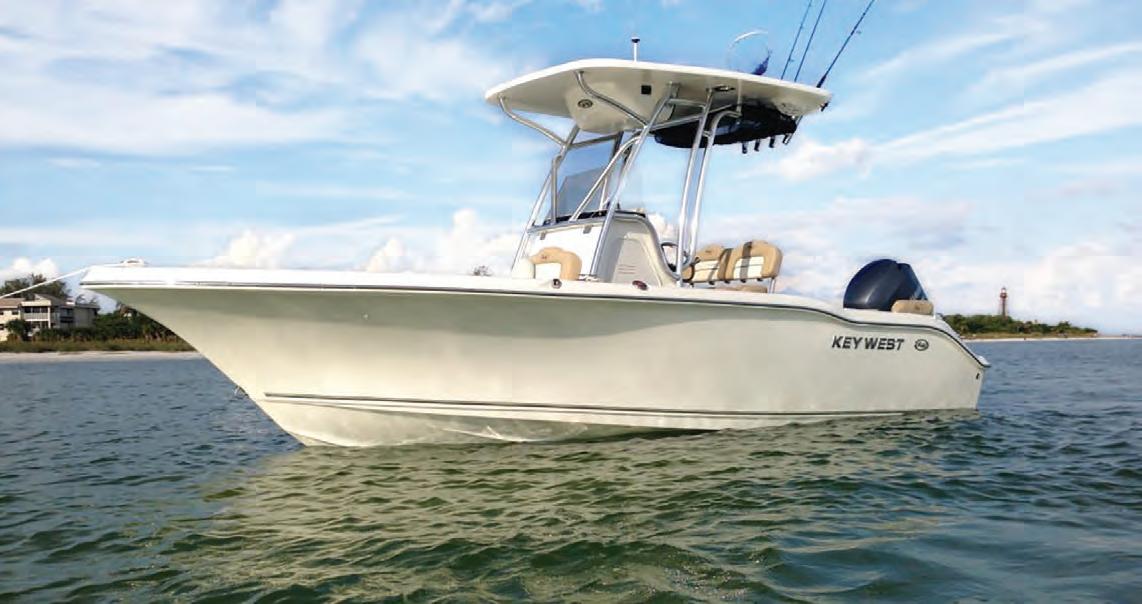



By Dominic Anderson
November in St. Augustine offers a fantastic transition period for anglers, as the cooler weather pushes many inshore and offshore species into more predictable patterns. Water temperatures will be steadily dropping, which generally means a move towards deeper holes in the intercoastal waterway for some species, and a strong bite for others as they prepare for winter.
Look for redfish to be schooling up in larger numbers as the month progresses. Target oyster beds, docks, and creek mouths during outgoing tides, especially in areas with good current flow. Live shrimp, mud minnows, and artificial lures like Gulp! shrimp or soft plastic jerkbaits will be effective. As temperatures drop, they may move into deeper residential holes. Trout fishing should be excellent in November. Focus on grass flats, particularly those with access to deeper channels or holes. Early mornings and late afternoons are prime times. Topwater plugs can still produce exciting strikes on warmer days, while suspended MirrOlures and soft plastics under a popping cork will be consistent producers. Flounder fishing remains strong through November as they begin their offshore migration. Target jetties, bridges, and inlets with live mud minnows or finger mullet on a Carolina rig. Jigging with bucktails tipped with Gulp! shrimp or live bait will also be effective. Expect to find black drum in similar areas to redfish, often mixed in with them. They’ll readily take live shrimp, cut bait, or even a piece of crab presented on the bottom. Early November can still offer good opportunities for king mackerel, particularly on warmer days. Trolling live bait or spoons around bait schools and structure will be key. Spanish mackerel will also be abundant, especially around the inlets and nearshore reefs; small spoons and Gotcha Plugs are effective. If conditions allow for trips further offshore, the cooler water can improve

the bite for various snapper and grouper species on natural and artificial reefs. Cobia can still be encountered around structure and often follow migrating baitfish. Live shrimp and mud minnows will be highly sought-after live baits for inshore species. Finger mullet may become scarcer as the month progresses, but if available, they are excellent for redfish and flounder.
Really try to focus on getting your hands on some sandfleas and fiddler crabs! Sheepshead are in and they’re biting! Near shore wrecks and reefs can hold some big ones and as it gets cooler they will begin to hug oyster beds, dock pilings and bridges. Time and time again chum has proven to get these fish fired up. While some days can be slow picking other days of chumming can have these fish jumping in the boat. You’ll want to use a small, short and sharp hook for these toothy fish. They scream drag for their size and are among one of the better inshore eating fish. Throw on a jacket and get to work these fish can be sneaky and will have you working to keep a bait on at times.
This time of the year can be pretty good fishing wise. Aim to fish lower tide as these storms and nor’easters will have the water way up. Try to fish hard after the storms before other anglers make it out. These fish are hungry and chewing on what they can find after these storms. Tight lines and we’ll see you out on the pond or in the ditch.
Capt. Dominic (904)-962-6184
Instagram:staugustine_fishing www.fishardy.com



by Carson Kent
It’sbeen a windy fall season for us! The fishing is still very good. As many people are focused on fishing for redfish on the flood tides, I like to shift my focus to low tides. Fall low tide sight casting for reds is hard to beat. It’s finally bearable to fish in the middle of the day, but I still recommend focusing on morning and afternoon low tides for your best shot at slot to overslot redfish on the flats. The last month or so the primary lure of choice has been a 3” shrimp lure. Specifically the Irukandji prawn lures

on their 1/6oz head. I’ve always used 1/8oz jigheads with small shrimp lures and paddletails but that extra bit is just enough to help cast with the wind that we’ve all been dealing with, but also not too heavy so that it
would spook the fish upon the lure splashing the water near the fish. As the water cools down we will start to see more abundant schools of redfish up shallow rather than the single fish or pods of two or three.
Flounder fishing is very good now, as it has been a very productive last few months fishing for them. Season is closed October 15th to November 30th, allowing the successful spawning and migration offshore. But they become an excellent catch and release species to fish for during these times due to their willingness to eat many varieties of bait and lures as well as their hardiness. Many flounder right now are staged up near ledges where creeks combine or where small creeks meet a main channel. In shallow water under 3 feet I use the same lures mentioned above but reduce the retrieve to a slow speed, bouncing the lure off the bottom. For deeper flounder a lure of choice among many local anglers is a 5” curly tail on a ½ to 1oz jig head.
By the time this edition comes out, the mullet run will begin to slow down, marking the last good bit of tarpon we will have in North East Florida, until next spring. If the mullet are thick through November we will see some tarpon left over. We’ve had an extremely productive tarpon season this year all the way from the beaches and inshore in St. Augustine to Mayport and way down the St John’s River.
I hope everyone has been on the water as much as possible despite all the weather we’ve been having. The fish don’t seem to mind it at all!
If large fish on artificial or sight casting redfish on light tackle interests you, give me a call at (904) 805-3949 or visit Deadlowfishing.com
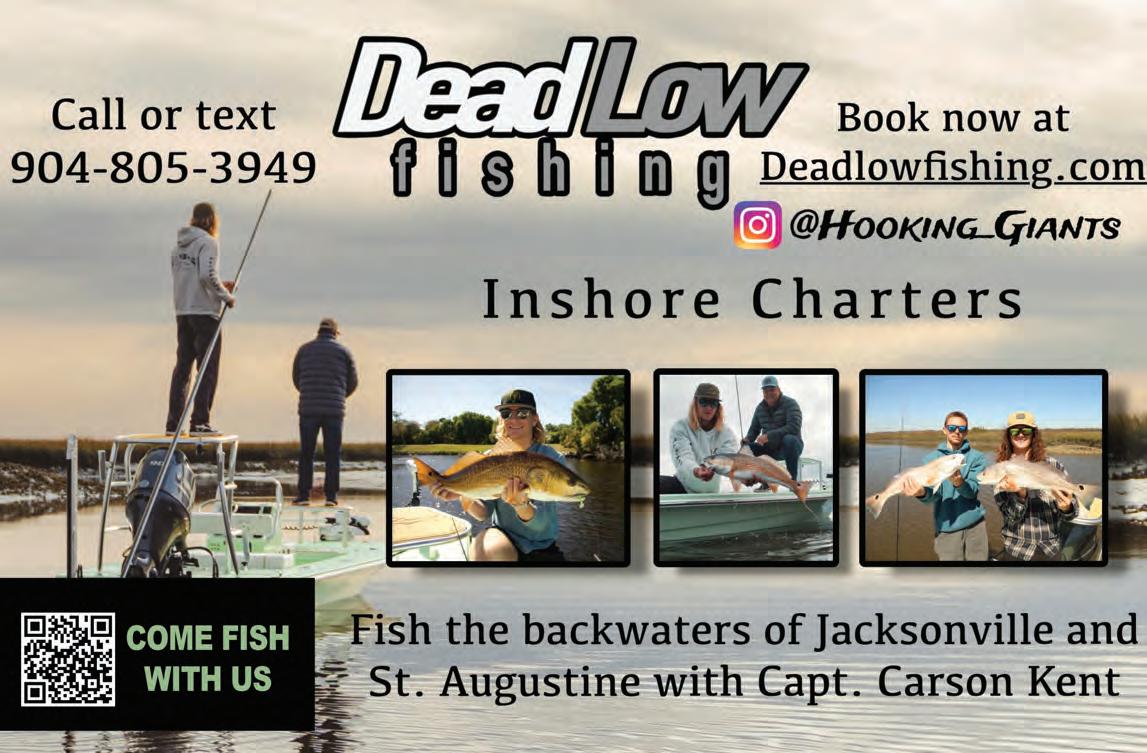
By Capt. Kirk Waltz
It’sbeen a tough few weeks closing up October and predicting what the fishing will be like in November. I can’t remember the last time I saw it blow for this many weeks for as hard as it has in memory. I believe that if we can get some calm conditions the fishing should get good. Look for the big spawning reds to continue to feed and migrate into this month if the water temperatures don’t drop considerably. I like to fish a whole blue crab with the legs cut off, a big chunk of fresh mullet, a chunk of ladyfish if I can find them or live croaker, pogies, or mullet . I work the edges of deep drops on the river channel edges, ICW, or the sand flats outside of the main jetties for best results. A stout rod using a 3-way swivel works best. My go to outfit is a 7ft Terova Med Heavy rod coupled with a Saragosa 6000 or 10000 spinning reel and 60lb PowerPro braid. I prefer 60-80lb mono leaders and a 7/0 live bait hook with the main leader about 36inches long.
The river edges and ICW creeks north and south will hold good numbers of reds, trout, sheepshead, drum and flounder. A light tackle spinning rod with a 1/4oz jig works great with a live shrimp, mud minnow, or a live finger mullet tossed on small creek


runouts, oyster beds, docks, and any rocky structures you can find. The falling lower tides produce the best so be sure to check your tide charts before you head out. A additional rod to add to your quiver should be one rigged with a sliding float rig or popping cork. This can be extremely helpful when fishing higher flowing water trying to locate fish. The creeks like Debels, Dutton, Cabbage to the south and Hannah, Garden, Broward to the north just to name a few.
The big rocks at Mayport should really turn on with the cooler weather. Reds, trout, Sheepshead, drum, ringtails, and flounder will be a few of the species feeding on this huge artificial reef. A light rod and a 1/4oz jig can be effective fishing the edges of the rocks with shrimp, fiddlers, cut blue crab, mullet and mud minnows. I prefer the high outgoing tides for better results and look for clean clear water. A float rig can also work really well at the rocks and reduce the number of snags you get when tossing jigs.
The offshore waters are great this time of the year if you can get the ocean to calm down and provide the opportunity to jump out a few miles. The bottom fishing can be stellar with catches of black sea bass, trigger fish, vermillions, snapper, grouper, and even a few flounder. The local party grounds are a good place to start. Try fishing with cut cigar minnows, Boston mackerel, cuttlefish, and squid . If live bait is present break out the Sabiki rigs and grab a few as fresh live bait is typically the best.
Good luck and remember you can’t catch them from the couch..
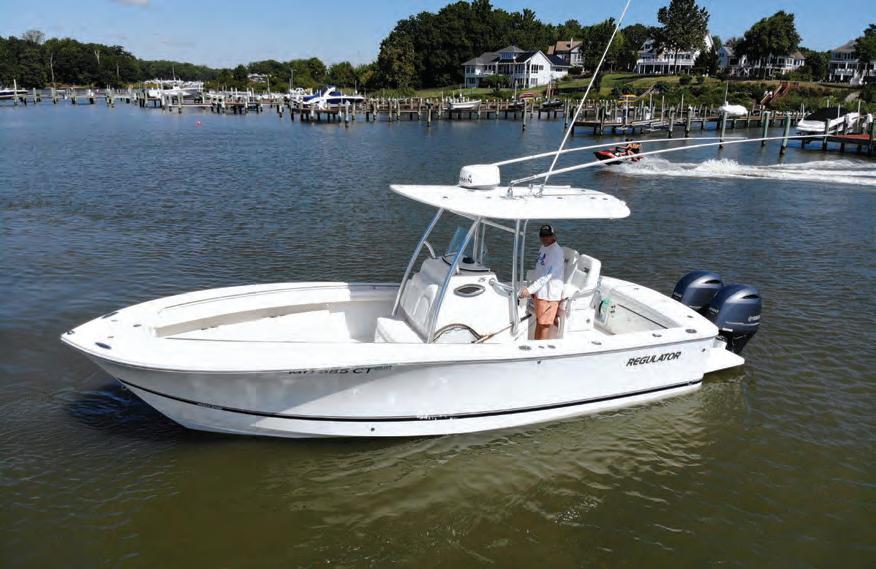



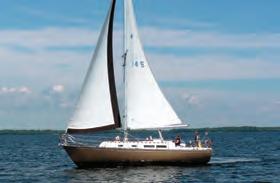

By Capt. Tony Bozzella
Many redfish will enter the backcountry this month as the October mullet run ends. Much more for them to eat with available food sources. Fiddler crabs, blue crabs, mud minnows & other crustaceans will be their diet. A TBS jig paired with shrimp can be a deadly combination. I like to get out the last 3 hours of the falling tide. Throw in the eddies behind oyster bars and be “in tune” with your bait. In other words, have your line tight enough that you feel the bite, but not tight enough that you’re moving and dragging the jig across the oyster shells. Make your 1st cast the best, so you don’t alarm any fish that are around the shell bar.
I prefer to stay as far back as I can by making accurate casts to my targeted area. I use the lightest TBS jig I can — usually a 1/8 or a 1/4 oz jig. By staying back, less noise & hull slap & disturbances. You may not see it, but you are in the fish’s house, & all that I mentioned adds up. It’s much like approaching a herd of deer — quiet & stealthy gets the ticket. I rig my rod with 15 lb braid with a Uni-to-Uni knot and add a 30-inch piece of 20 lb fluorocarbon, and
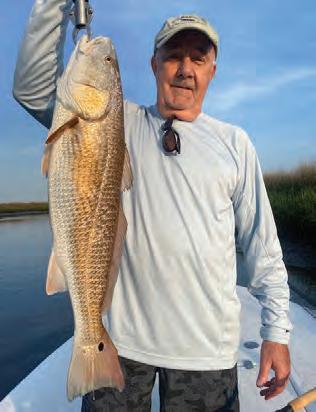

then a bowline to tie my jig on. This is by far the best rig for my backcountry fishing. Just pair the weight of the jig with the depth & current.
There will be other species caught — black drum & sheepshead, trout & flounder. All good table fare. As far as the black drum and sheepshead, I pretty much use the same exact rig I mentioned; however, I will use fiddler crabs or shrimp for bait, as they are not much fish eaters.
Still in the window for a good flounder. I like incoming water, and my favorite bait is a TBS bucktail rigged with a mud minnow, finger mullet, or a piece of Gulp. This combination has been good producers. I throw the bucktail up current around docks and structure and hop the jig slowly across the bottom, waiting for the “thump.” Then reel in any slack in the line and set the hook, keeping tension, as flounder are notorious for coming off the hook.

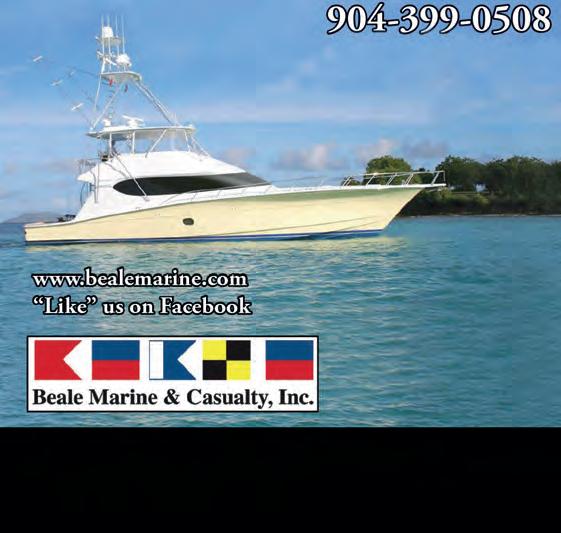


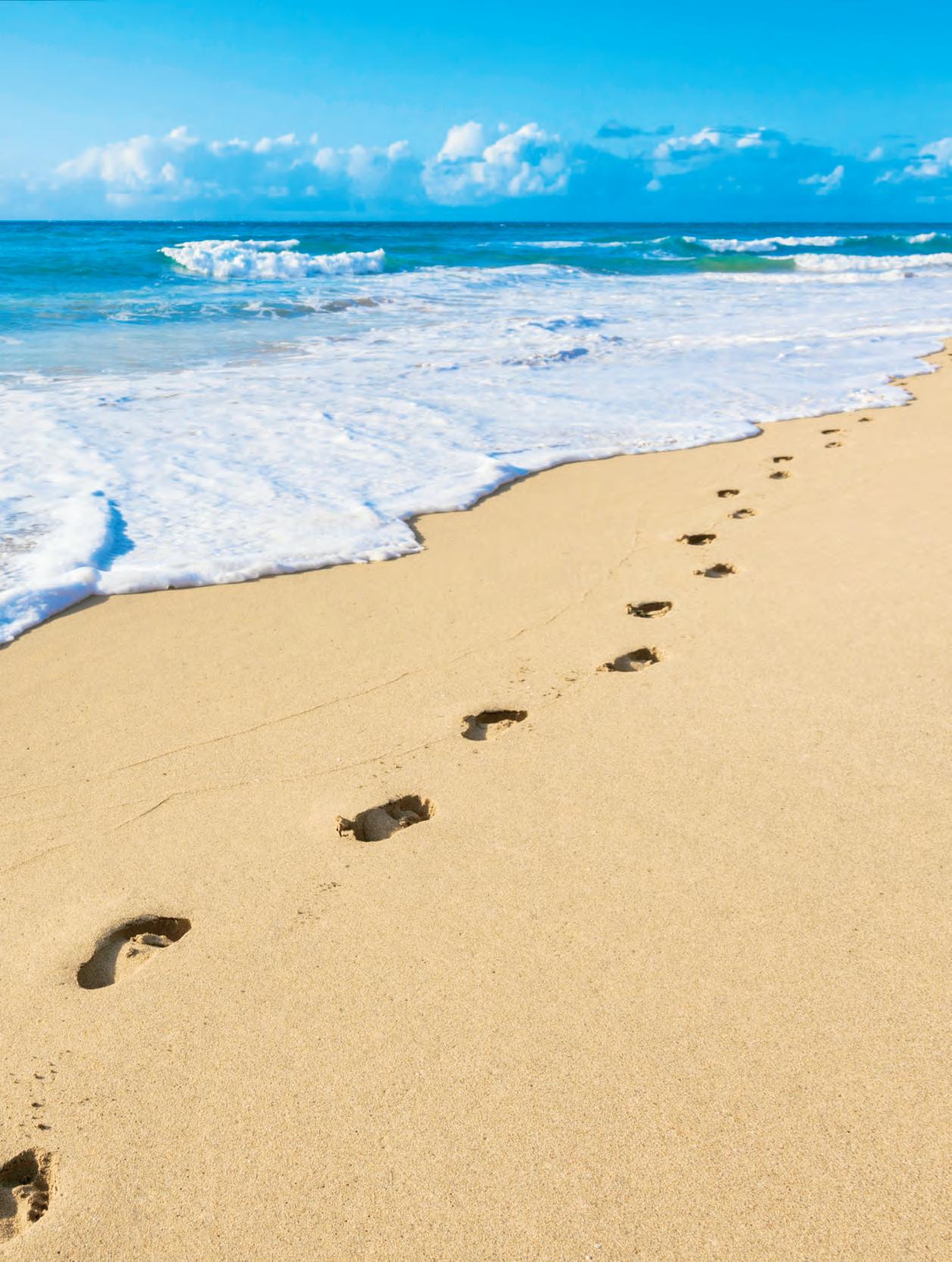



20 Thu 01:36 AM 0.58 L 08:04 AM 5.53 H 02:20 PM 0.60 L 08:24 PM 4.64 H 21 Fri 02:12 AM 0.63 L 08:42
23


By Joey Bloom, Copper State Tackle Tournament Pro
There’s nothing quite like the rst real cold front of fall in the Southeast. One week you’re wearing a short-sleeve shirt and chasing schooling sh under bluebird skies, and the next, you’re bundled up, watching your breath in the morning fog, wondering where those sh disappeared to. When the water temps take that rst noticeable drop— usually sliding from the mid-70s into the 60s—it marks a big turning point in fall shing. e bass feel it too, and their behavior changes almost overnight.

A er a strong cold front, the rst thing I notice is how much tighter sh get to cover. ose aggressive, roaming schools that were chasing bait across shallow ats will suddenly scatter. e sudden high pressure that follows a front can make sh sulk and suspend, and the feeding windows get short. It’s not that they stop feeding entirely—they just reposition and get more selective. For me, this is when slowing down and thinking about the why behind each cast becomes crucial. Bass are still following the bait—usually shad— but their movements tighten up. I’ll start by checking shallow areas near deep water access, like secondary points, creek channel bends, or riprap banks near the mouths of pockets. ese are transition zones where bass can adjust depth easily as the temperature and pressure uctuate.
When those water temps dip, I turn to con dence baits that match the conditions and the mood of the sh. A lipless crankbait is one of my rst picks—it gives o a rattle and tight wobble that’s perfect for cooler water. I’ll run something like “Bill Lewis” 1/2 oz trap in a natural shad colors along



shell bars, grass patches, or around isolated wood. e key is to sh it methodically—make contact with cover and pop it o en. If the lipless bite feels o , I downshi into nesse mode. A 1/2-ounce jig with a Bait Cave Customs Cave Cricket Craw trailer is deadly around docks, brush, or isolated laydowns. I’ll pitch it on lighter line and really soak each piece of cover. e colder the water gets, the longer I’ll let that bait sit.
Another underrated player this time of year is a suspending Rapala jerkbait. When bass suspend er a front, that slow, twitch-pause-twitch cadence can trigger bites from sh that otherwise wouldn’t move far. On high-pressure bluebird days, I might make a cast, let the bait sit ten seconds, and only then give it a twitch. It’s all about patience and timing.
e best post-front patterns o en come down to consistency. Look for areas with a stable food source—places where bait sh stack up despite changing conditions. In reservoirs across the Southeast, that might mean a windblown main-lake point one day and a calm pocket the next. Keep an eye on your electronics, follow the bait, and don’t be afraid to adjust your depth until you see life.
Cold fronts separate the patient from the impatient. It’s a time to slow down, sh smart, and make every cast count. e bass might be moody, but they’re still there—and with the right mindset and a few Copper State Tackle baits on your line, you can turn those tough post-front days into opportunities.
Pro Tip: When in doubt, start with a lipless crankbait to cover water and locate active sh. Once you nd them, pick up a jig or shakey head with a Bait Cave Customs ick Stick worm to milk the area for those extra bites. You can grab both at Copper State Tackle—the gear I trust when every ounce matters. Follow all of Joey Bloom’s shing and fun on Instagram, Facebook, and YouTube at Joey Bloom Fishing.
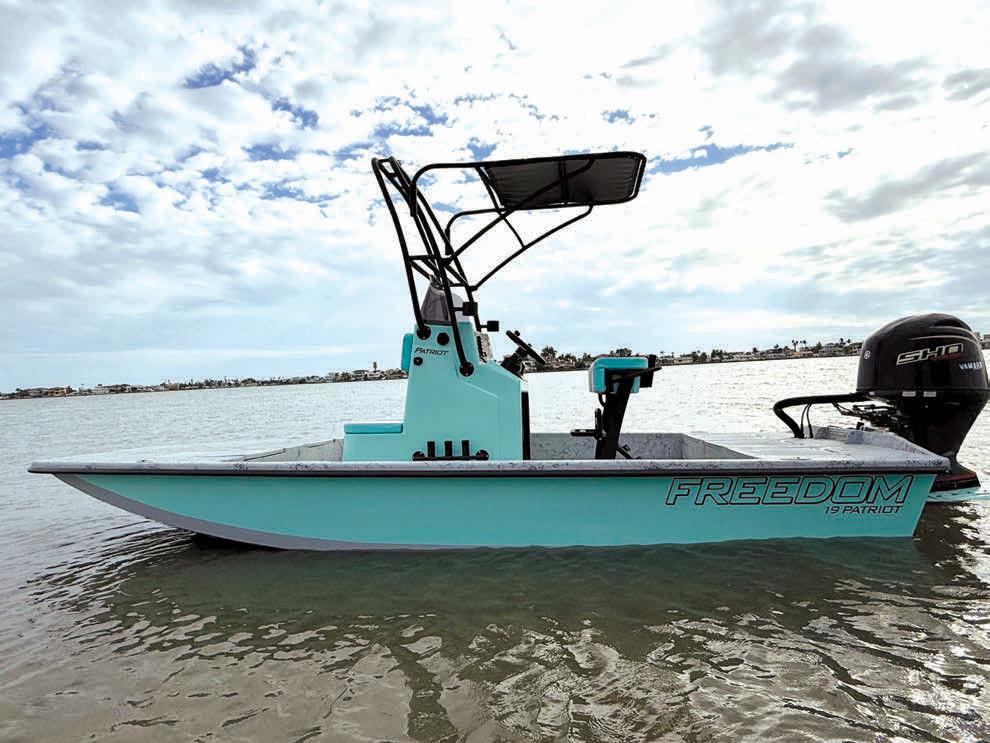


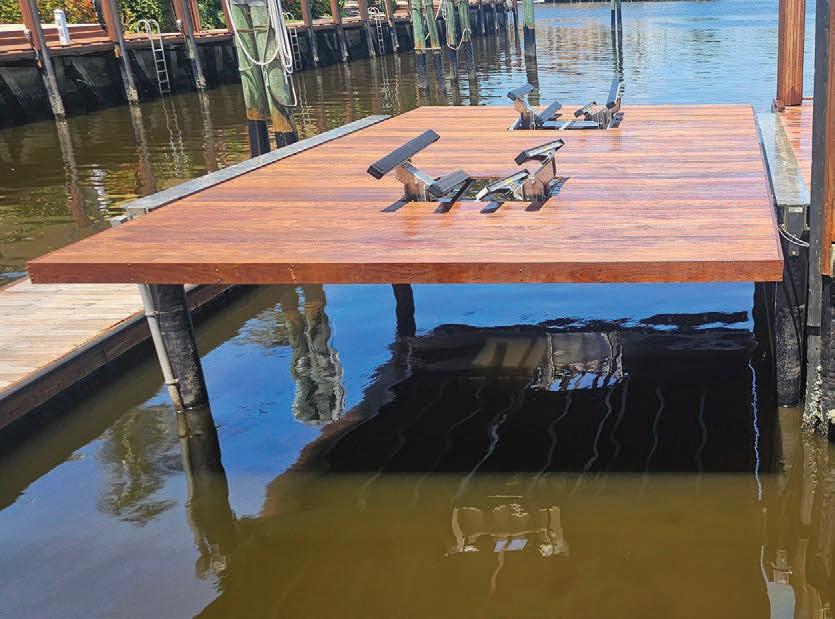



ShoreStation hydraulic boat lifts are a reliable choice for coastal residents and boating enthusiasts alike. Their strong construction, made with corrosion-resistant materials, allows them to withstand harsh environmental conditions, including sun, storms, and saltwater damage. ShoreStation provides a steadfast solution for protecting waterfront investments, o ering peace of mind to owners in the Sunshine State.
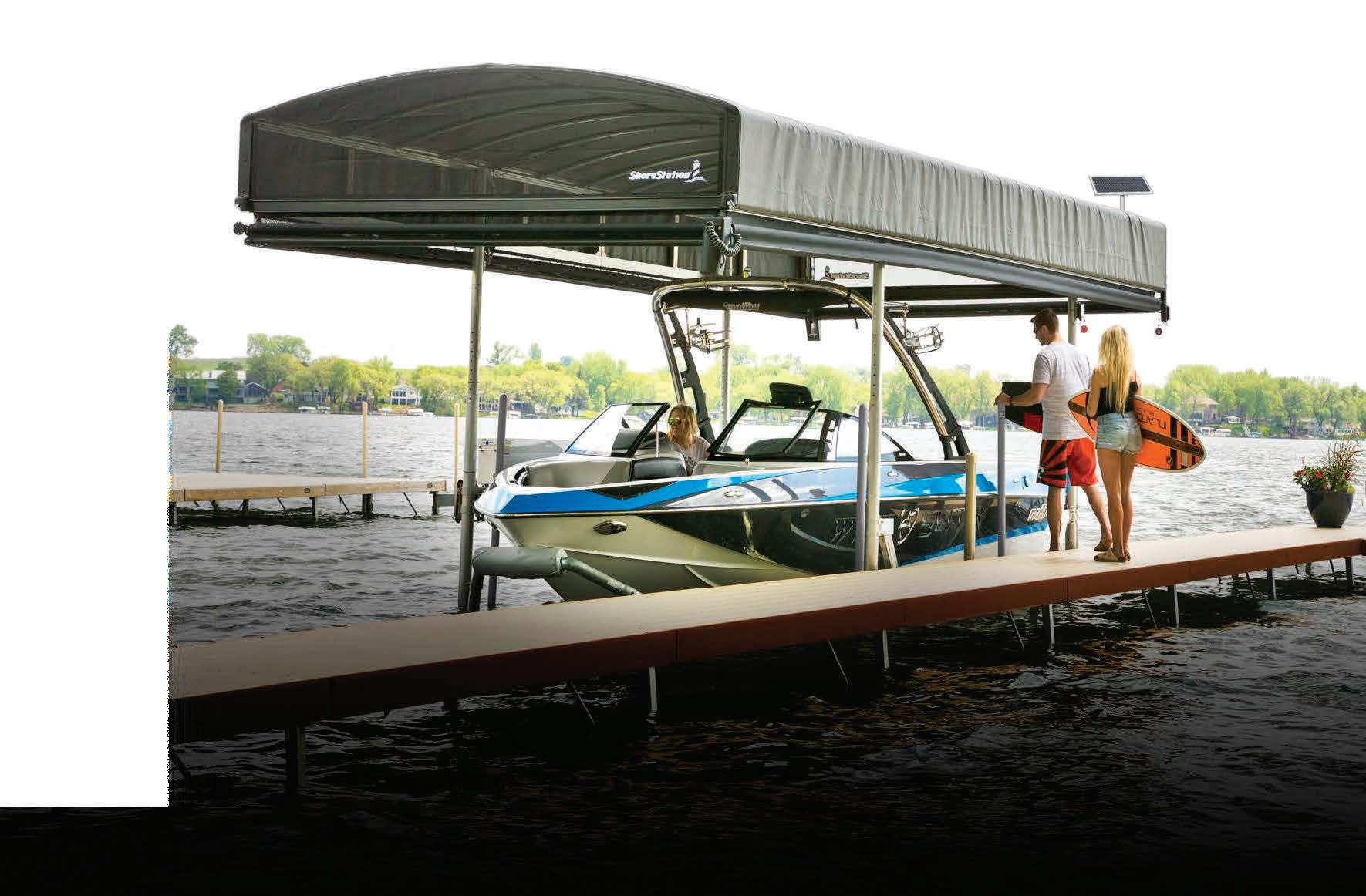
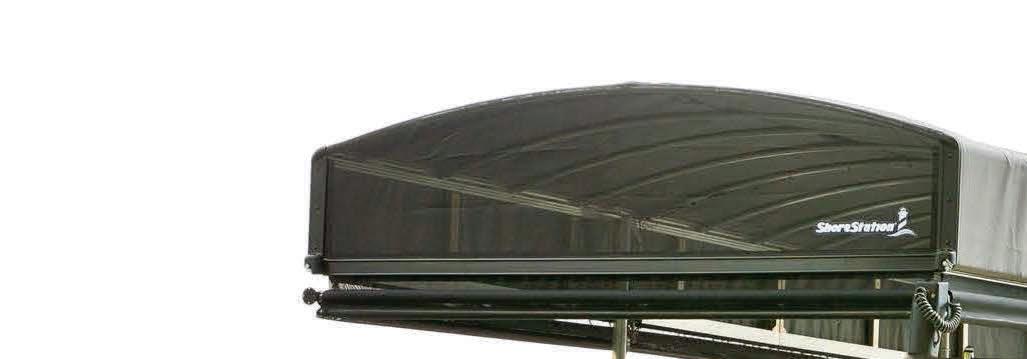
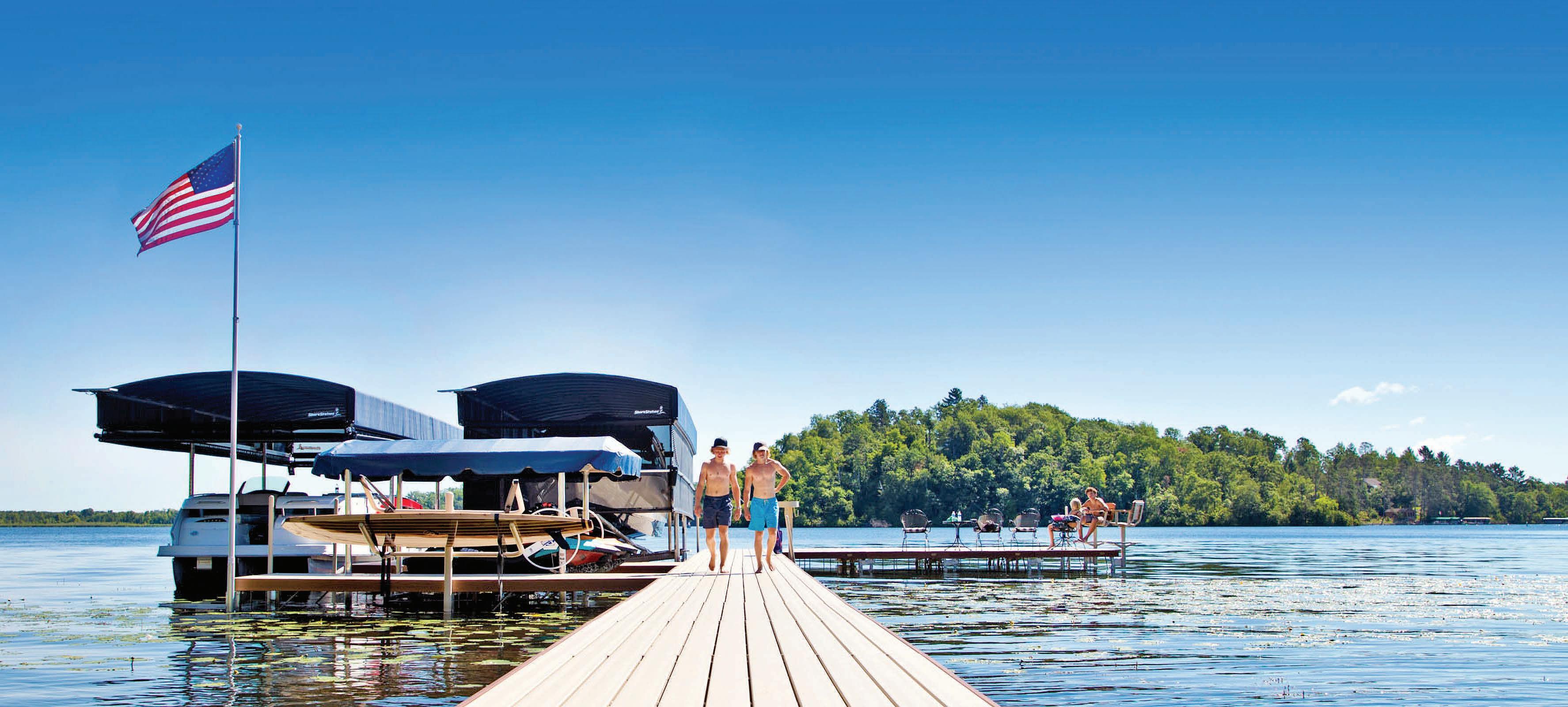



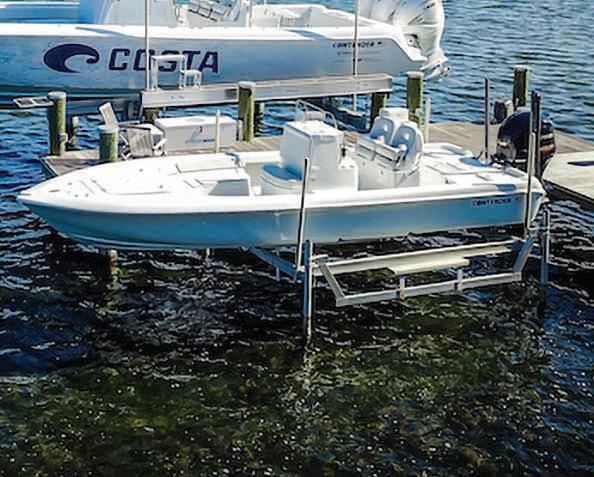
Equipped with exceptional weather resistant fabric and breathable SunTex 80 woven mesh ends for maximum protection and durability,

Made from the highest quality materials, our innovative hydraulic boat lift is one of the fastest and safest lifts on the market today. When you have a hydraulic lift, there’s no need to worry about wind and waves getting in your way. This lift will give you con dence to safely land and secure your boat in less-than-ideal conditions.
Never miss another moment on the water. Power your lift with clean, free solar power. Our speedy 20 watt charger features solar regulator drainage protection, saving your battery from permanent damage caused by overcharging.



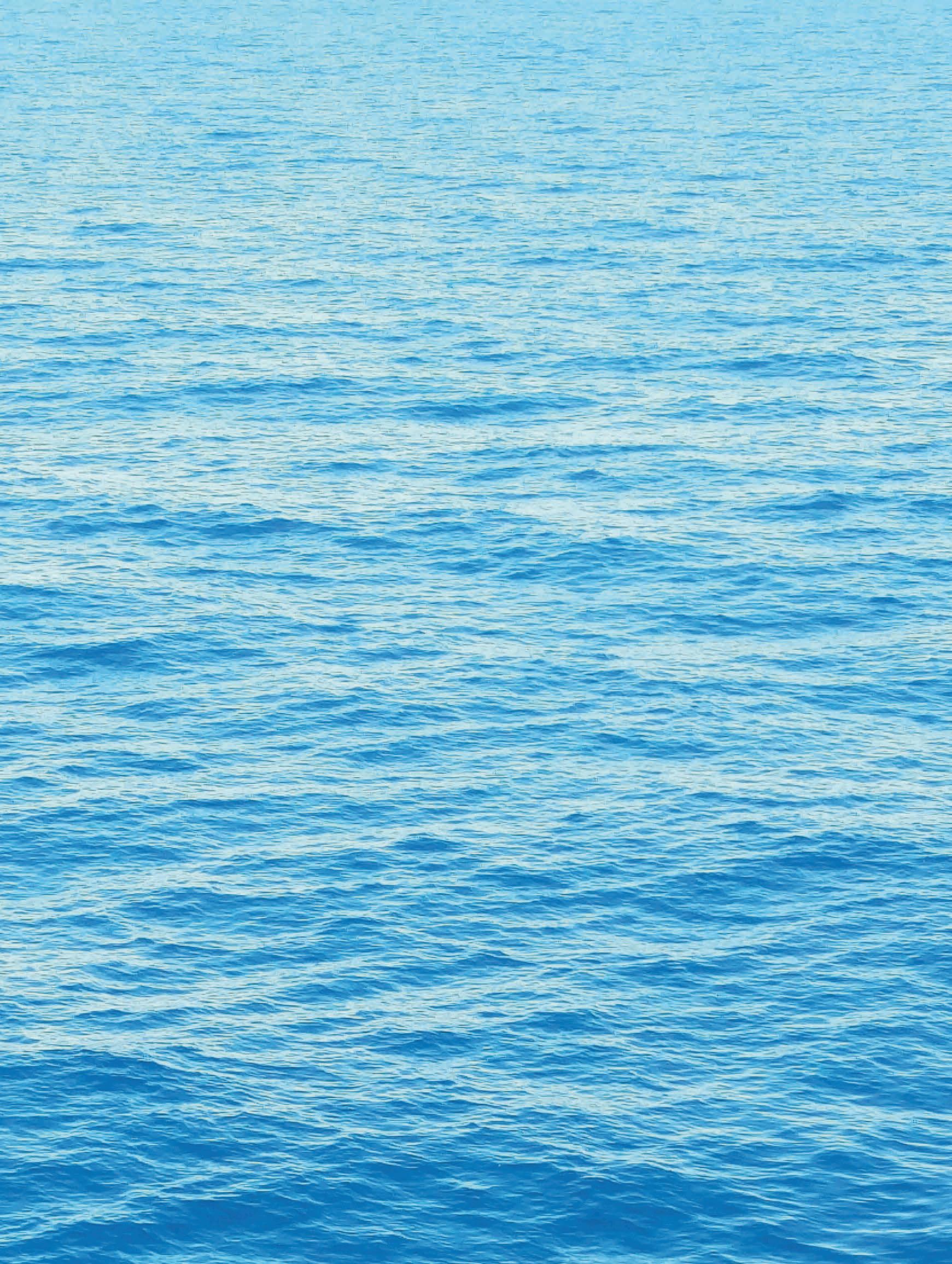

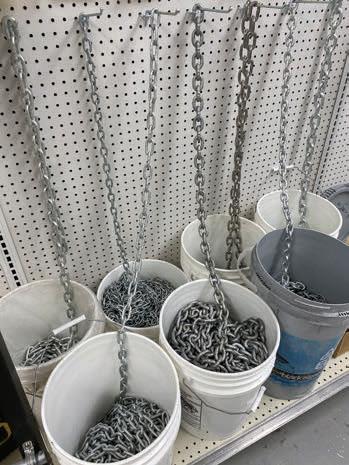
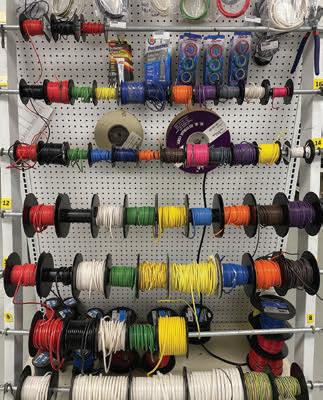

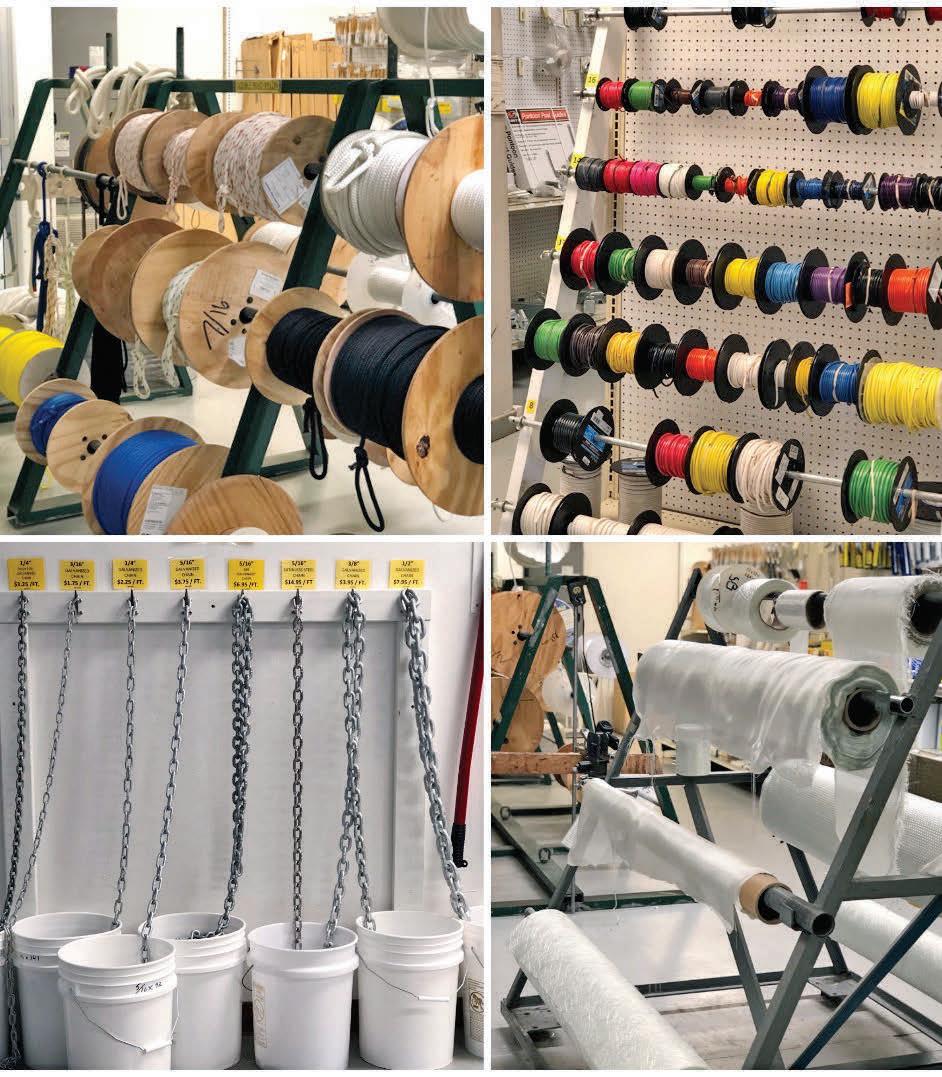
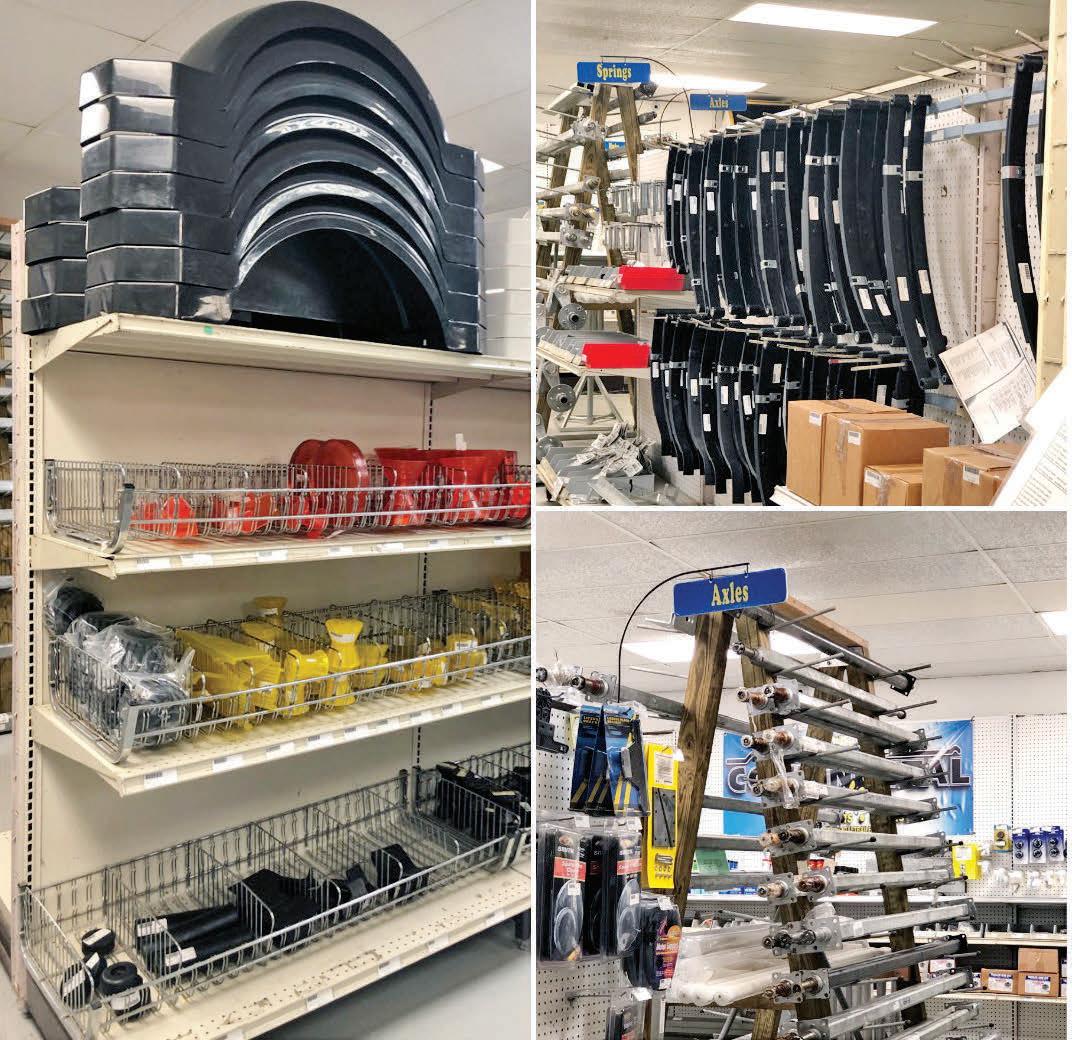





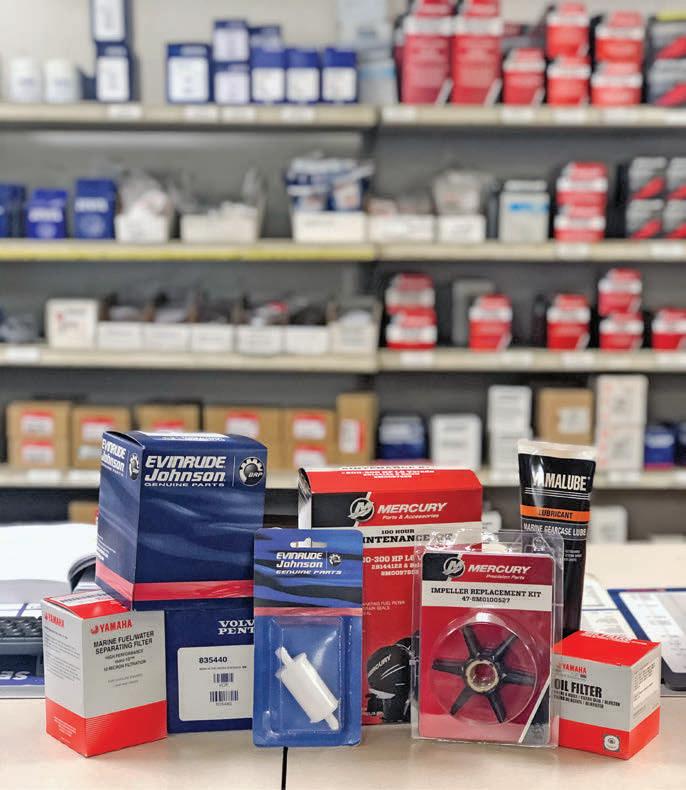
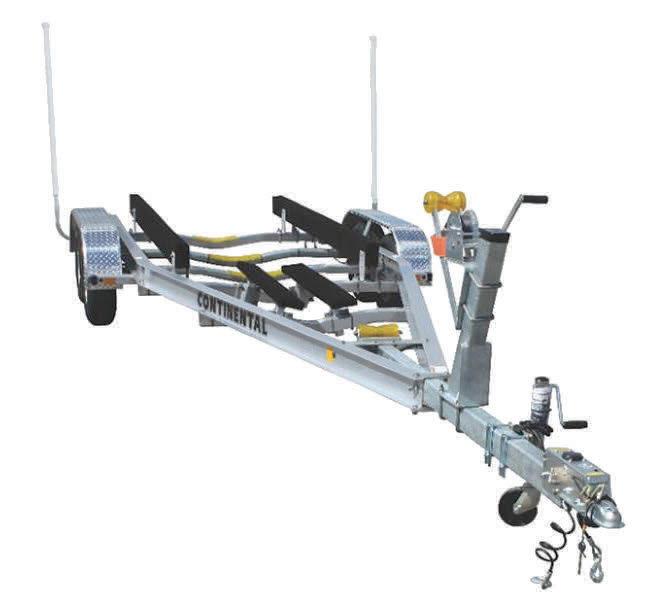





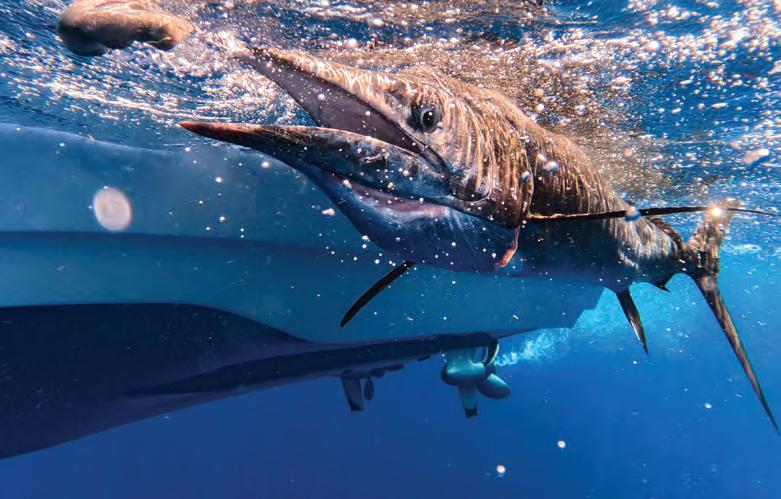
By Will Schmidt
Sail!sh are known as the fastest !sh on the planet, but they o er more than blazing speed to those who chase them o Florida’s east coast, such as I did on a recent !shing excursion. Spectacular surface bites and astonishing acrobatics make these !sh a coveted catch for even the most experienced anglers. For !rst timers, it’s an adrenaline !led !ght that will stick with you long a er the !sh swims back into the cobalt blue Atlantic. is trip was special for a few reasons. First, we had rising country star Ben Gallaher (IG: @Ben_Gallaher) with us. Ben is an avid outdoorsman and bass !sherman, but he had never caught a saltwater !sh. I was also excited to !sh with some new friends, Capt. Geoge Gozdz of “Unfathomed” (IG: @captgeorgegozdz) and Chris Bishop, VP of marketing at Yo-Zuri (iG: @Yozuri_Lures).
A er just a short run o Port St Lucie, we set our spread, and I could sense any strikes would likely be dramatic. e water was crystal clear and glass at giving us a great view of any action. e !rst !sh in, came crashing into the spread chasing and slashing at a bait with its bill. Unfortunately, as aggressively as it came in, it turned and retreated without eating.
As we reset the spread anticipation grew to !nd Ben’s !rst saltwater adversary. Fortunately, another sail came in a smashed the right rigger. However, it ran right at us, and we were never able to get tight. Undaunted, we set up again. Soon all the baits were nervously darting on the surface. e le atline erupted as the sail slashed, splashed and devoured the bait. Ben was on, and this !sh leapt and twirled with all the acrobatics of a Cirque du Soleil show. ere was still another to eat and moments later we doubled up. Both !sh cooperated with plenty of arial antics and a er a good !ght we had both !sh to the boat. To say Ben was pumped to land his !rst bill!sh is an understatement. Amped up with adrenaline and ready for more he could only beam with an ear-to-ear grin and say “let’s go!”
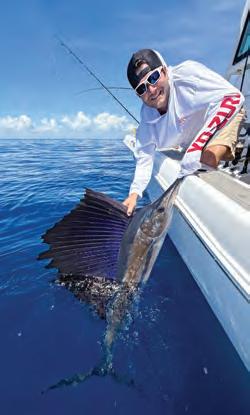
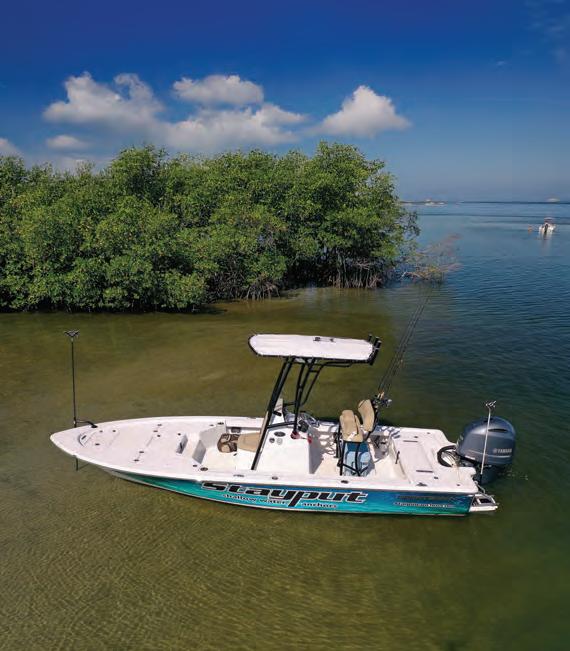


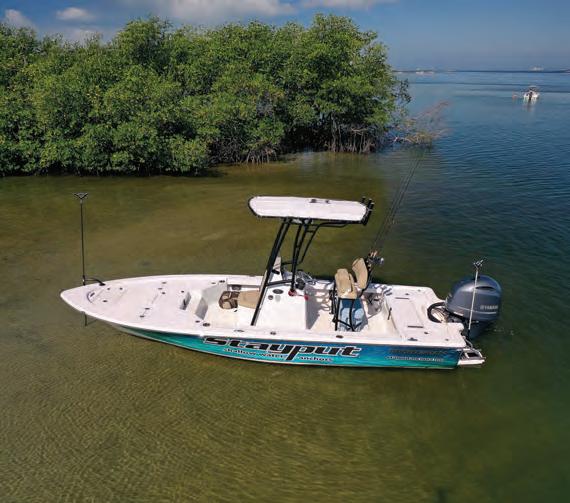

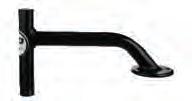



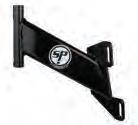

Fall !shing o of Port St Lucie o ers warm water and a hot bite without having to battle high winds and cold temperatures o en associated with winter sail!sh !shing in Florida.. Moreover, it’s not di&cult at all. We were simply bump trolling large, bridled thread!ns. Bridling helps the bait last longer and doesn’t allow for the hook to turn into the thread!n causing a missed strike. Our tackle was medium Penn Carnage rods with Authority reels lined with Yo-Zuri Super Braid topped with Yo-Zuri’s Disappearing Pink Fluorocarbon leader. ese setups gave us the sensitivity to feel the “eat” and the stealthiness to fool even the most cautious of !sh in these clear conditions. On your next trip don’t rush past these exciting sails, stop for some fun acrobatic action.
Will Schmidt is a seasoned tournament angler who has been writing about shing for more than two decades. Follow Will on Instagram @saltynstrong.

